Recent Storm Damage Posts
Flood Zones and Your Island Heights Home
5/3/2023 (Permalink)
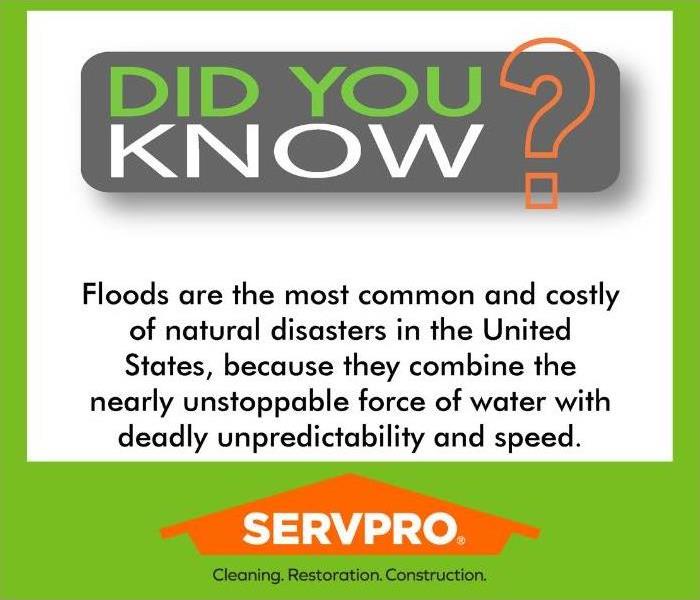 As a leader in flood damage restoration, SERVPRO of Toms River has the specialized training to restore your home back to its pre-flood condition.
As a leader in flood damage restoration, SERVPRO of Toms River has the specialized training to restore your home back to its pre-flood condition.
If you live in Island Heights you may be wondering if your property is at a high flood risk. According to Risk Factor, “There are
229 properties in Island Heights that have greater than a 26% chance of being severely affected
by flooding over the next 30 years. This represents 23% of all properties in Island Heights.” Just because some areas of Island Heights have a greater chance at experiencing a flood, doesn’t necessarily mean flood damage is going to happen to your home. It is always best to be prepared, below we have couple tips about these zones and how they could affect your home:
- What is a Flood Zone? Flood zone describes the risk of flooding for a specific area. Everyone lives in a flood zone- it’s
just classified between low, moderate, or high risk. FEMA determines these risk levels and you can locate this information at FEMA Flood Map Service Center. - Do I Need Flood Insurance? In New Jersey, if your home is in a high risk flood zone area you might be required to have flood insurance in order to qualify for a mortgage. In most cases, flood insurance is a separate policy than your homeowners or renters insurance. Discussing this with your insurance agent is the best way to determine this and see what your options are. Although flood insurance is not mandatory, it is always best to have coverage.
- What to do if a Flood Happens? If a storm causes flooding in your home, you need to contact SERVPRO of Toms River as quickly as possible for storm damage repair. Our highly trained team of professionals have the necessary equipment to extract large amounts of water and restore your property back to its original condition. It is important to act fast to prevent further damage to your home and potential mold growth.
What Natural Disasters Can Happen in New Jersey
4/26/2023 (Permalink)
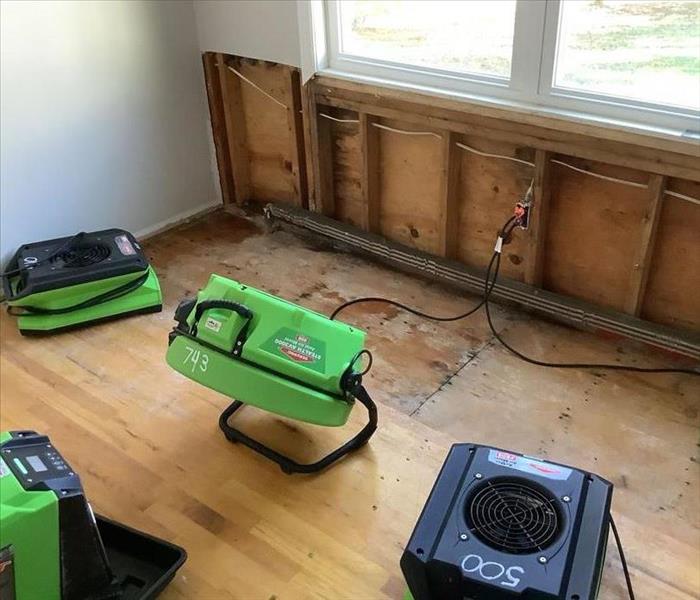 We’re dedicated to responding immediately to storm damage emergencies because a fast response helps limits further damage and reduces cost.
We’re dedicated to responding immediately to storm damage emergencies because a fast response helps limits further damage and reduces cost.
New Jersey is the fifth smallest state and home to over 9 million people, being the most densely
populated state in the U.S. That’s because New Jersey has so much to offer from the beaches,
dense forests, city life, mountains and much more. But what happens when a sudden
destructive storm affects your Silverton home?
Primal Survivor has provided a list of the most
common natural disasters in New Jersey so you can be prepared:
- Floods: New Jersey’s elevation is at 250ft and the highest elevation point is 1,803ft, making the state prone to flooding. New Jersey has over 18,000 miles of streams and rivers and due to sea levels and rainfall increasing along with tropical storms, there is a higher risk of flooding. Flooding can occur all over New Jersey but some parts are more susceptible to it. Climate change is also adding to the risk.
- Hurricanes: New Jersey rarely gets hit directly by hurricanes. Often times it receives the remnants of the hurricane, because of how densely populated it is when it does the damage can be severe.
- Heavy Snowfall: Between October and April New Jersey brings between 40-50 inches of snow. January and February are the coldest months of the year with temperatures typically in the high 30s. According to USA.com NJ ranks # 24 for the most snowfall in the country.
- Freezing Rain: If the temperature is 32 degrees or colder, when the rain hits the surface it turns to ice. This most commonly occurs in the months of December and January. The biggest issue with this is it leads to icy roads causing treacherous driving conditions.
- Heat Waves: Heat days are increasing in New Jersey with the average of 5 “dangerous” heat days per year. National Weather Service defines it as days with the heat index 103F or above.
- Wildfires: According to the state Forest Fire Service, New Jersey averages about 1,500 wildfires per year. New Jersey forests consist mostly of hardwood and there isn’t a lot of undergrowth, so the fires don’t spread as quickly.
- Tornadoes: On average New Jersey gets about two tornadoes per year. There have been 182 confirmed tornadoes in New Jersey since 1950. Because of how densely populated the state is, even F1 and F2 tornadoes can cause severe property damage.
Storm damage to your property is not something any of us want to experience. As long as
yourself and your loved ones are unharmed, the rest can be restored. SERVPRO of Toms River
is a leader in storm and water damage restoration with specialized training and expertise to restore your property back to its pre-storm condition. Our restoration process puts an emphasis on scientific drying techniques, progress monitoring and documentation.
Severe Weather and Keeping Safe from Storms and Hurricanes
4/10/2023 (Permalink)
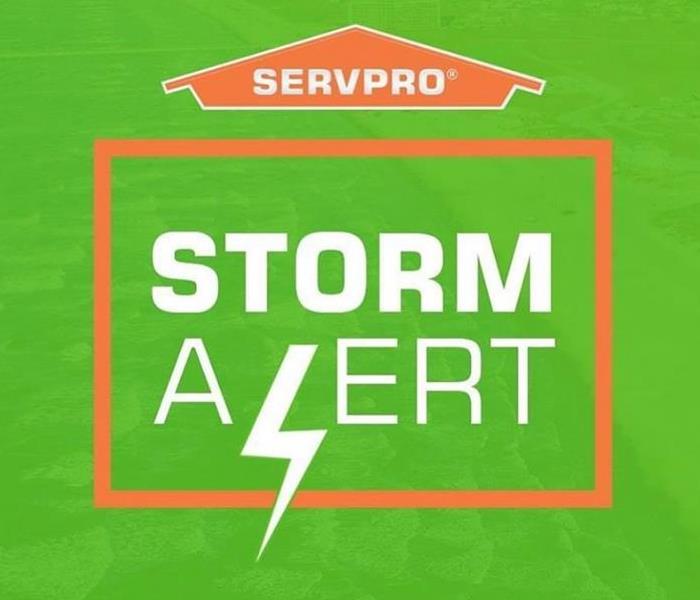 SERVPRO of Toms River responds immediately to your flood and storm damage emergencies.
SERVPRO of Toms River responds immediately to your flood and storm damage emergencies.
Severe weather in Ocean County can happen at any time. While it may be difficult to prepare for the unpredictable, there are steps you can take now to help ensure you are ready when disaster strikes.
Before the storm:
- Build an emergency supply kit
- Develop a communication plan
- Unplug any electrical equipment that doesn’t need to be used in case of lightning
- Secure outdoor objects
- Shutter or board up windows and doors
During the storm:
- Stay indoors
- Use radio or TV to keep updates on changes
- Avoid contact with corded phones
- Avoid contact with electrical equipment or cords
- Avoid contact with plumbing as they can conduct electricity
- Stay away from doors and windows
After the storm:
- Never drive or walk through a flooded areas
- Stay away from storm damaged areas
- Stay away from downed power lines and report them immediately
The first step to becoming weather ready is to understand the types of hazardous weather that can affect and impact where you live and work. Learn the important terms that may happen in your area. Here is a list of common weather terms for the Ocean County area that you may hear before, during and after a storm:
- Storm surge is the abnormal rise of water generated by a storm’s wind. This can travel several miles inland, especially along bays, rivers and estuaries.
- Flooding is when water covers or submerges normally dry land with a large amount of water and can persist for several days after a storm has dissipated.
- Winds from storms can damage and destroy buildings.
- Tornadoes can accompany landfalling storms and can occur in rain bands away from the center of a storm.
- Dangerous Waves can pose significant hazard and damage to coastal residents’ structures and businesses, even when the storm is more than 1000 miles offshore.
- Watch is for conditions that are possible to become a for severe weather event. Remain alert for further warnings.
- Warning is when severe weather has been spotted or indicated by radar. This means that severe weather is expected and to take cover immediately.
Floods and storms don’t wait for normal business hours, and neither do we. You can depend on an immediate response from our highly trained technicians at SERVPRO of Toms River.
How to Check Your Home for Storm Damage in Island Heights
2/10/2023 (Permalink)
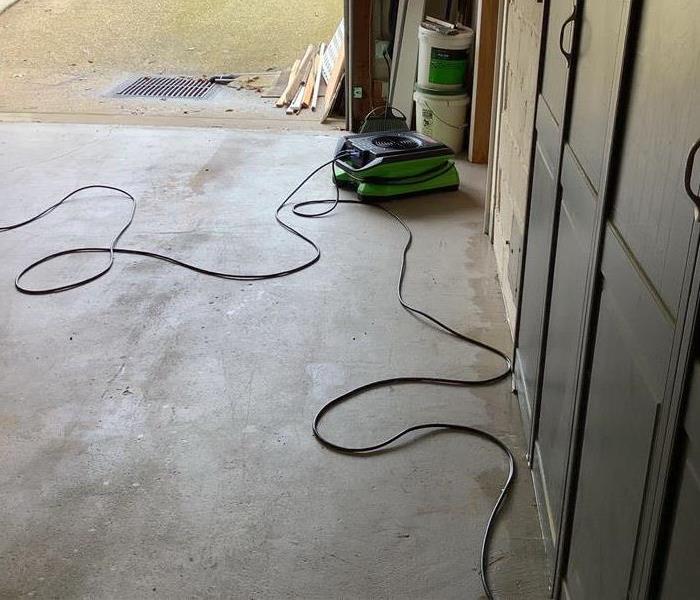 SERVPRO of Toms River drying out the garage in a home in Island Heights, NJ.
SERVPRO of Toms River drying out the garage in a home in Island Heights, NJ.
Your roof is designed to weather the elements of a bad storm. Your shingles, flashing and gutters can be damaged from heavy rain, hail, lightning, and wind. When the roof is exposed, other damage can easily occur from the seeping of water or holes from flying debris. If you suspect your roof experienced storm damage, investigate as soon as possible after the storm passes so secondary damage does not happen.
Signs you may have storm damage:
- Cracked, curled or missing shingles.
- Gutters with water buildup.
- Check your ceilings for water spots and yellow, copper, or brown discoloration.
- Check your siding for large dents.
- Attic, basement, and crawlspace for mold or wood rot and leaks.
Also, it is important to check around the entire house. It is easier to see the dents at dusk or dawn.
Remember that hail and windstorms tend to be directional, so one side may be damaged while the remaining side are fine.
If you realize you have experienced storm damage, call your local restoration experts at SERVPRO of Toms River. We are available at 732-349-9898 for 24/7 all storm damage emergency cleanups.
Seaside Heights Flood Safety Facts
1/31/2023 (Permalink)
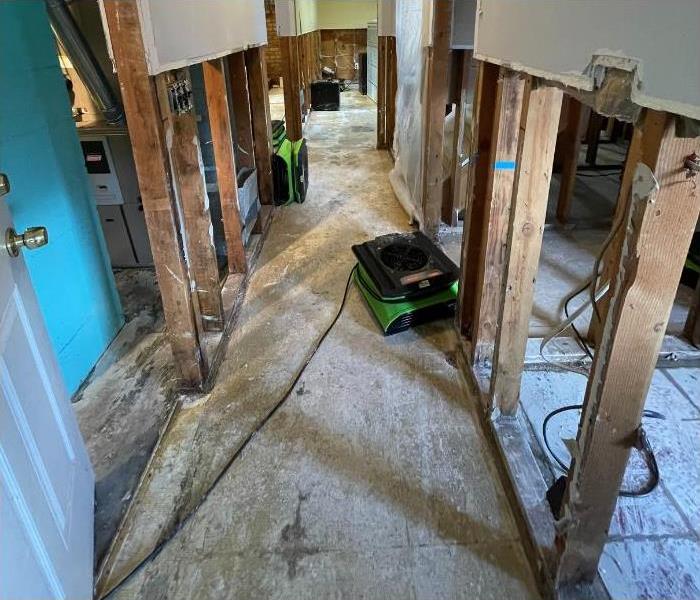 After the flood waters recede, SERVPRO of Toms River will begin the drying and reconstruction process to restore your Seaside Heights property.
After the flood waters recede, SERVPRO of Toms River will begin the drying and reconstruction process to restore your Seaside Heights property.
There are 2,067 properties in Seaside Heights that have greater than a 26% chance of being severely affected by flooding over the next 30 years. This represents 92% of all properties in Seaside Heights. There is always potential for
flood damage no matter where you live. According to National Geographic, “Floods are among Earth’s most common and most destructive natural hazards”. During a flood it is in your best interest to stay away from floodwaters. If you come up on a flowing stream where water is above your ankles, stop, turn around and go the other way. Six inches of swiftly moving water can sweep you right off of your feet. If you happen to approach a flooded road while driving, turn around and go another way. If you are caught on a flooded road and waters are rising rapidly around you, get out of the car quickly and move to higher ground. Most cars can be swept away by less than two feet of moving water. Never walk on beaches or riverbanks. Beaches are changing environments influenced by the force of the ocean. Always keep children away from the water. Children are curious and often lack judgment about running water. Not only is it extremely dangerous, the water may be contaminated with sewage or contain dangerous insects or animals. Even minor floods have the potential to cause major damage.
If water damage occurs and you are in need of a professional water damage restoration expert, call SERVPRO of Toms River. We are faster to any size disaster. call us at 732-349-9898 24/7 for any size flood water cleanup emergency.
There is Never a Shortage of Storms in New Jersey
9/9/2022 (Permalink)
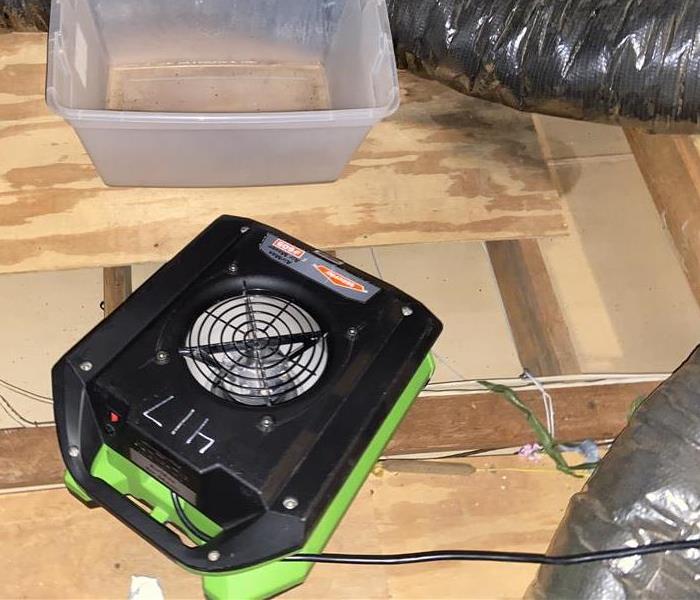 SERVPRO of Toms River drying equipment in the attic of a Toms River home after a heavy rainstorm.
SERVPRO of Toms River drying equipment in the attic of a Toms River home after a heavy rainstorm.
Living in Toms River, our homes and business are not only surrounded by the Atlantic Ocean, Barnegat Bay, the Toms River and many lagoons, but there are numerous pipes that bring an estimated 80-100 gallons of water per person per day to and from our homes. With all the natural and manmade sources gives Toms River residents and business owners many different causes for a water damage to strike your property. Since 2012, Ocean County has experienced many natural events that caused severe water damage to our area including:
SERVPRO of Toms River has handled the water damage cleanup for many of these events. Established in 2001, we have proved that we are the leader for water damage cleanup in our Ocean County community. Our highly trained technicians are available 24 hours a day, 7 days a week and 365 days a year. We respond quickly to all size water damage emergencies at your Ocean County property. Our technicians will monitor and document the process from start to finish to ensure your peace of mind. Call SERVPRO of Toms River as soon possible and let us handle the water damage cleanup process.
Day Four of Hurricane Preparedness Week: Flood Insurance
5/4/2022 (Permalink)
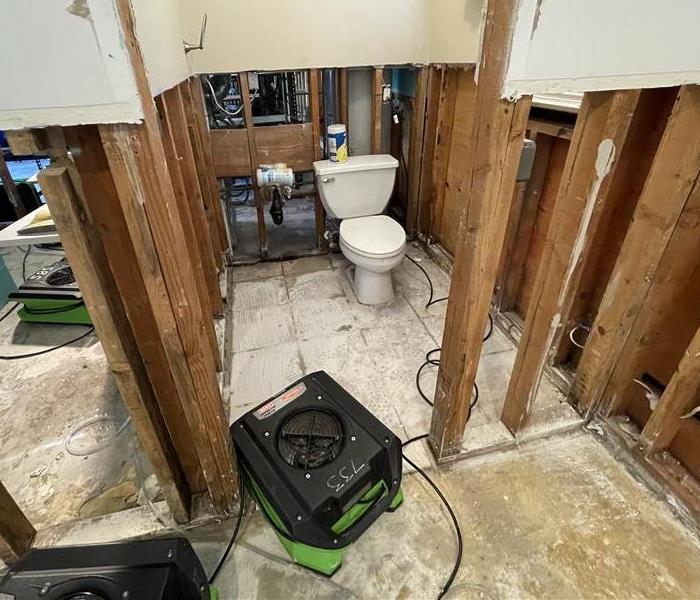 SERVPRO of Toms River uses advanced equipment and scientific drying techniques to repair your home after a flood.
SERVPRO of Toms River uses advanced equipment and scientific drying techniques to repair your home after a flood.
Being prepared with flood insurance can help you rebuild your home faster and stronger. No home is completely safe from the risk of potential flooding. Floods can happen anywhere and just one inch of floodwater can cause up to $25,000 in damage, according to FEMA If you’re not protected, you could be responsible for paying for costly damage all on your own.
Need Flood Insurance?
Call your insurance company or insurance agent, or ask a friend or family member who they use or contact The National Flood Insurance Program (NFIP) to get a quote as soon as possible. Plan ahead as there is typically a 30-day waiting period for an NFIP policy to go into effect.
Currently Have Flood Insurance?
Do an insurance check-up: make sure you have enough insurance to repair or even replace your home and/or belongings. Remember, home and renters insurance doesn’t cover flooding, so you’ll need a separate policy for it.
Flooding can be an emotionally and financially devastating event. With flood insurance, you're able to recover faster and more fully.
Have Storm or Flood Damage?
Major storms and flooding events can overwhelm many restoration companies. On the other hand, SERVPRO of Toms River has helped many people in the aftermath of hurricanes and flooding, including Superstorm Sandy. We are storm and flooding damage specialists who get started promptly to get your property dry and back to pre-flood and pre-storm condition.
Day Three of Hurricane Preparedness Week: Emergency Disaster Kit
5/3/2022 (Permalink)
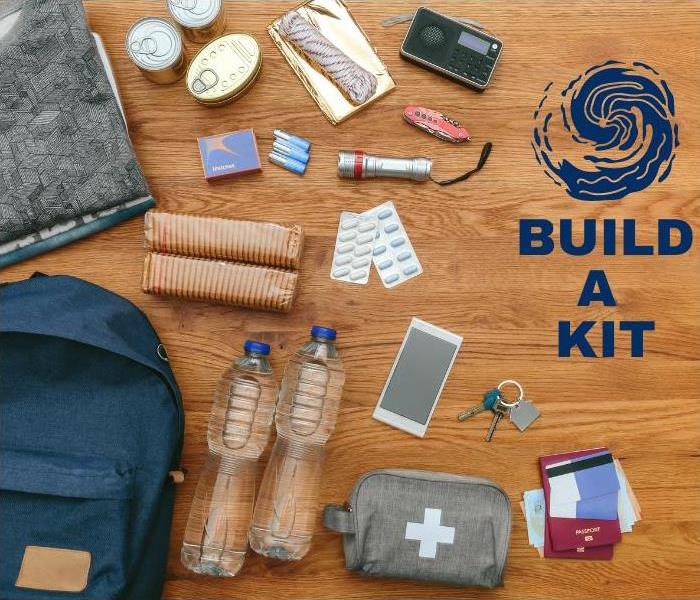 Be hurricane ready!
Be hurricane ready!
When preparing for hurricanes, having supplies to make it through the hurricane isn’t enough. Ensure you have supplies for the recovery period, which could be very long depending on the damage. In some cases, water, electricity and gas could be out for a day or even over a week. You may need to survive on your own for several days so having an emergency hurricane disaster kit in the event of a hurricane could be a life saver.
What is an Emergency Hurricane Disaster Kit?
An emergency hurricane disaster supply kit is a collection of basic items your household may need in the event of an emergency.
What Items Should Be in the Hurricane Emergency Disaster Kit?
- Cash-banks and ATMs may not be open or available for extended periods.
- Water-at least one gallon per person per day for three to seven days, plus water for pets.
- Food-at least enough for three to seven days, including: Non-perishable packaged or canned food and juices, food for infants and the elderly, snack food, paper plates, plastic utensils.
- Manual can opener (non-electric)
- Radio-battery powered and NOAA weather radio with extra batteries.
- Blankets, pillows etc.
- Clothing-seasonal, rain gear/ sturdy shoes.
- First Aid Kit-plus medicines, prescription drugs, vitamins
- Special items-for babies and the elderly.
- Toiletries-hygiene items, moisture wipes, sanitizer.
- Flashlight and batteries.
- Keys
- A portable crank or solar-powered USB charger for your cell phones.
- Toys, books and games.
- Pet care items, proper identification, immunization records, ample food and water, medicine, a carrier or cage, leash.
Once you take a look at the basic items consider what unique needs your family might have, according to Federal Alliance for Safer Homes.
How Much of Each Should Be in Your Emergency hurricane Disaster Kit?
Have enough non-perishable food, water and medicine to last each person in your family a minimum of 3 days (store a longer than 3-day supply of water, if possible) to ensure your family's basic comfort and well-being.
How Should These Items be Safely Stored?
To assemble your kit store items in airtight plastic bags and put your entire disaster supplies kit in one or two easy-to-carry containers such as plastic bins or a duffel bag.
Where Should Your Emergency Hurricane Disaster Kit Be Kept?
This kit should be kept at home in a designated place and should be have it ready in case you have to leave your home quickly. Make sure all family members know where the kit is kept.
What Should You Do to Keep the Supplies Updated?
Remember to replace stored food and water every six months, keep a supply of fresh batteries on hand. Re-think your needs every year and update your kit as your family’s needs change.
Day Two of Hurricane Preparedness Week: Evacuation
5/2/2022 (Permalink)
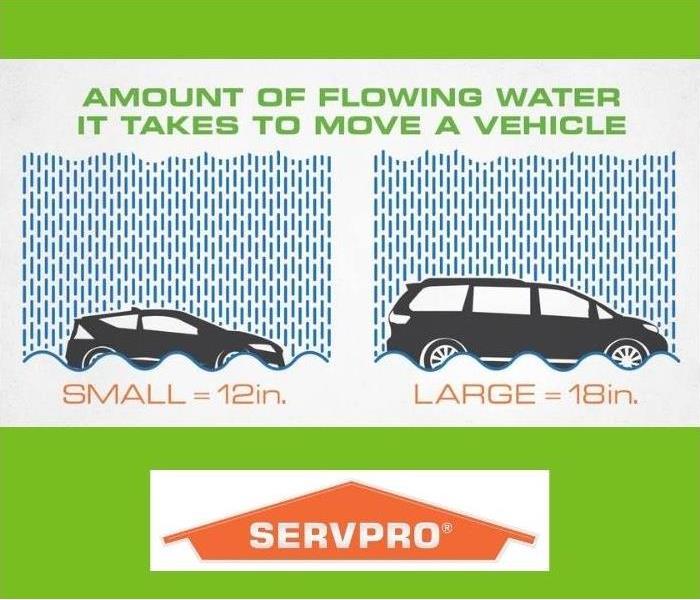 Two feet of rushing water can carry away most vehicles, including SUVs and pickups.
Two feet of rushing water can carry away most vehicles, including SUVs and pickups.
Day Two Hurricane Preparedness Week: Evacuation Plan
If you live in a hurricane evacuation zone or your area is prone to flooding you may need to leave your home. Also, if you reside in a mobile home and near an evacuation zone you may also need to leave your home. Now is the time to begin planning where you would go and how you would get there.
As hurricane season approaches, listen to local officials on questions related to how you may need to adjust any evacuation plans your local officials.
Do You Know New Jersey’s Coastal Evacuation Routes?
They show the various state roads that have been identified as potential evacuation routes for coastal emergencies in Ocean County such as approaching Tropical Storms or Hurricanes. You can prepare for an evacuation by using a local map to identify the roads you would take to reach these Evacuation Routes from home, work or any place where you and your family spend time.
Remember that all evacuation plans, including the evacuation routes posted are flexible and may change based on the nature of an emergency.
When local, county or State officials order you to evacuate, they will provide specific information about the roads you should take. Police and first responders will be posted in your community to direct traffic and block roads that are unsafe. Click here to find the Ocean County and surrounding coastal evacuation maps from the State of New Jersey Office of Emergency Management.
What Should You Do If Your Evacuation Route Gets Flooded?
Always avoid driving into flooded areas! Remember to “Turn Around, Don’t Drown” is the motto of NJ.gov in the event of bad weather and flooding.
A flash flood occurs within a few hours (usually less than 6 hours) of heavy or excessive rainfall, a dam or levee failure, or the sudden release of water. Flash flood warnings and area-based flood warnings are issued as tropical systems make landfall. Many flash flood fatalities occur at night.
A flood develops more slowly, normally taking more than 6 hours. Area-based flood warnings may continue for days or weeks until flood waters have receded.
Water is very powerful. Six inches of fast-moving water can knock you off your feet. Two feet of rushing water can carry away most vehicles, including SUVs and pickups. Most flooding deaths occur in automobiles.
Day One of Hurricane Preparedness Week: Risk Assessment
5/1/2022 (Permalink)
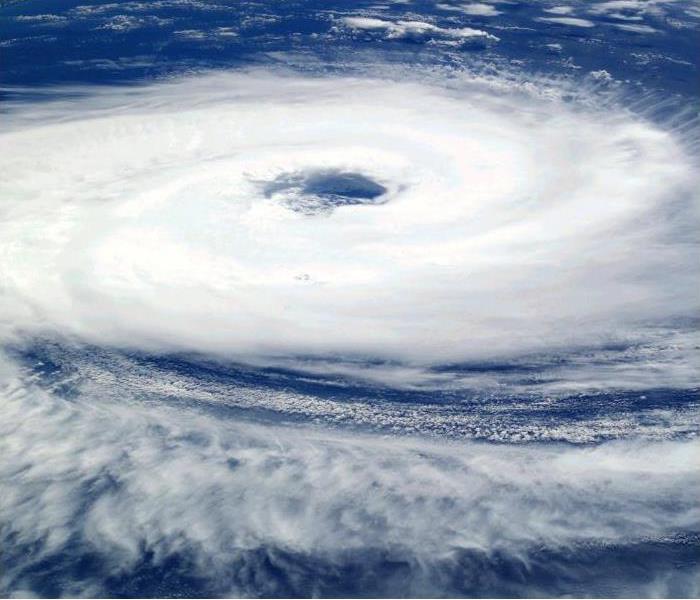 Determining your risk is the first part of Hurricane Preparedness Week for 2022!.
Determining your risk is the first part of Hurricane Preparedness Week for 2022!.
To kick off Hurricane Preparedness Week, the first part of preparation is determining your risk. Everyone lives in an area with some flood risk, it’s just a question of whether you live in a high-risk, low-risk, or moderate-risk flood area.
Do You Know Where to Track a Hurricane?
Learn about your flood zone and know your risk. The NOAA can help you with its Historical Hurricane Tracks Tool that uses your zip code to display paths of past storms related to your location.
Can You Predict Your Chance of Flooding Due to a Hurricane?
Using flood maps can show you your community’s risk of flooding. Specifically, flood maps show a community’s flood zone, floodplain boundaries, and base flood elevation.
What Are Flood Maps?
Flood maps show a community’s risk of flooding. Specifically, flood maps show a community’s flood zone, floodplain boundaries, and base flood elevation.
Where Can You Find Your Flood Map?
You can find your flood map on the FEMA Flood Map Service Center.
Can Your Flood Risk Change?
How water flows and drains can change due to new construction and community development or natural forces such as changing weather patterns or terrain changes. Also, communities may build levees and dams, decreasing flood risk over time. Although the frequency or severity of impacts cannot be changed, FEMA is working with federal, state, tribal and local partners across the nation to identify flood risk and promote informed planning and development practices to help reduce that risk through the Risk Mapping, Assessment and Planning (Risk MAP) program. To better reflect your current flood risk, the National Flood Insurance Program and the Federal Emergency Management Agency use the latest technology and data to update flood maps nationwide.
SERVPRO of Toms River Offers Emergency Storm & Flood Damage Cleanup in Seaside Heights
4/15/2022 (Permalink)
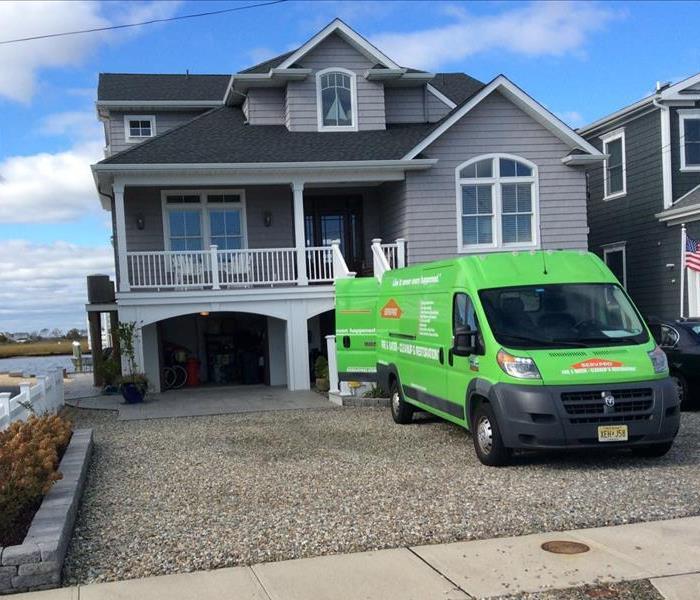 There are a little over 2000 properties in Seaside Heights that have greater than a 26% chance of being severely affected by flooding.
There are a little over 2000 properties in Seaside Heights that have greater than a 26% chance of being severely affected by flooding.
Living at the Jersey Shore, flooding is something a lot of us are familiar with. There are two types of flooding that are the most common in Ocean County are flash floods and coastal floods. Below is a brief description of each:
Flash floods are a sudden local flood, typically due to heavy rain. They can also be caused by dam or levee breaks, or mudslides (debris flow). The intensity of the rainfall, the location and distribution of the rainfall, the land use and topography, vegetation types and growth/density, soil type, and soil water-content all determine just how quickly the Flash Flooding may occur, and influence where it may occur. If people are at their homes or businesses, the water may rise quickly and trap them, or cause damage to the property without them having a chance to protect the property, according to the National Weather Service. Flash Flooding is possible everywhere. The normally tranquil streams and creeks in your neighborhood or area can become raging torrents if heavy rain falls overhead.
Coastal floods are when the coast is flooded by the sea. It occurs when low-lying land is flooded by seawater. According to Washington Coastal Hazards Resilience Network, common causes of coastal flooding are:
- Storm surge-changes in atmospheric pressure can elevate seawater levels during a storm, pushing more water toward the shore.
- Wind-driven waves-wind can push water higher and further onto land, causing coastal flooding.
- High tides and king tides-high tides can combine with other factors to cause coastal flooding. King tides are exceptionally high tides caused by one or more astronomical events happening at the same time.
- Sea level rise – as daily tides become higher smaller magnitudes of storm surge, wind and other factors will result in coastal flooding.
- Increased river flows – increased river discharge, caused by changes in rainfall, groundwater storage, and melting snowpack, can combine with seawater levels to flood coastal areas.
Severe weather from hurricanes, thunderstorms, and floods can cause significant damage to your Seaside Heights property. Water can be extremely destructive and the longer it remains, the more damage it could cause to your property.
When it comes to storms and floods, few people anticipate that it will actually cause damage to their home, whether it be water damage from either storm or a flood, SERVPRO of Toms River provides emergency water damage cleanup restoration services. We are available 24 hours a day, 7 days a week, 365 days a year, including holidays.
April Flowers Bring May Flowers or Property Damage to Ocean County?
4/15/2022 (Permalink)
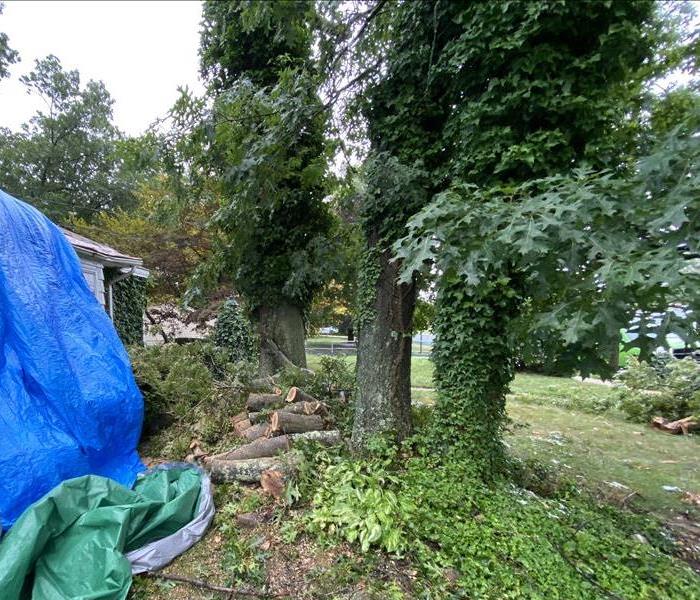 A tree fell on the roof of this home in Ocean County causing storm and water damage to the interior of the home.
A tree fell on the roof of this home in Ocean County causing storm and water damage to the interior of the home.
It's finally Spring! The daylight begins to stay out longer, the days begin to warm up a little, but then you remember it's still April. April gives us lots of wet weather here in Ocean County. Yesterday was a perfect example. People were outside enjoying the 80 degree day when all of a sudden the sky darkened and the storms rolled in. Wind gusts picked up and there was a sprinkling of lightening in there too.
Thunderstorms are common this time of year in New Jersey, especially in the afternoon and evening hours in the and can produce very dangerous lightning. Follow these safety tips from the American Red Cross to stay safe if a storm rolls in:
Where there is thunder, there is lightning! If thunder can be heard, then you are close enough to be in danger of lightning strikes. Go indoors!
Postpone any outdoor activities, such as sporting events and picnics until the storm passes. It is possible to get struck by lightning even if it is not raining.
Take shelter in a building or vehicle with windows closed and stay clear of the windows.
We can follow these tips to stay safe but unfortunately, there is no foolproof way to completely protect your house from lightning damage, wind damage and storm damage. Following a storm, in order to prevent further damage, it is always important to look for signs of roof damage. Some things to look for are holes, missing or dented shingles, and dented or cracked gutters and downspouts.
SERVPRO of Toms River responds immediately, any time, day or night to a storm damage emergency. A quick response is crucial to help limit the additional interior damage and understand the importance of responding quickly to help prevent secondary damage and reduce restoration costs. Our team can provide temporary protective measures to prevent additional damage to the property after a storm including board ups, temporary fencing and portable power.
Hopefully the storms will end at the end of the month and May will bring flowers to New Jersey instead of property damage!
The Blizzard of 2022
2/22/2022 (Permalink)
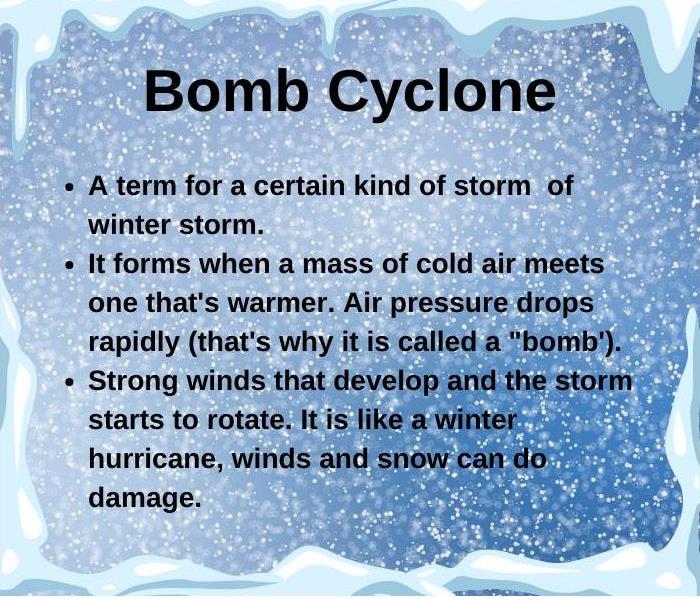 What is a bomb cyclone?
What is a bomb cyclone?
The Blizzard of 2022!
Ocean County, along with the Eastern Coast of Ney Jersey, was expecting a severe winter storm to hit here the last weekend in January. The storm started late on Friday night and by Saturday morning the nor'easter brought lots of gusting winds that were blowing sideways. Some areas had wind gusts of 70 mile per hour. Bands of snow and wind clobbered the Jersey Shore throughout the day. Drifting snow from the wind made snow totals hard to measure.
When is a snow storm considered a blizzard?
A blizzard is defined as three or more hours of visibility reductions to one quarter mile or less due to falling or blowing snow, and sustained winds or frequent gusts of 35 mph or greater. The National Weather Service confirmed Blizzard Conditions along the entire coastal strip of New Jersey from Cape May to Sandy Hook, NJ during the Nor’easter of January 28 and 29, 2022.
Saturday morning, the air pressure dropped and the storm rapidly turning into a bomb cyclone.
What is a bomb cyclone?
A "bomb cyclone" is a term given to a rapidly strengthening storm that fulfills one important criterion. Generally, pressure must drop 24 millibars (a unit of pressure) within 24 hours. However, that benchmark is also based on the latitude of the storm. So, the millibar requirement can change depending on where the storm forms, according to CNN.
Have storm damage in your Toms River business or home?
Let SERVPRO of Toms River handle all of your storm damage cleanup. We are your local water damage specialists who get started promptly to get your property dry and back to pre-storm condition. Using advanced equipment and scientific drying techniques, we document the drying process to validate your home or business is ready.
Winter Weather Heading to Ocean County on January 28, 2022
1/27/2022 (Permalink)
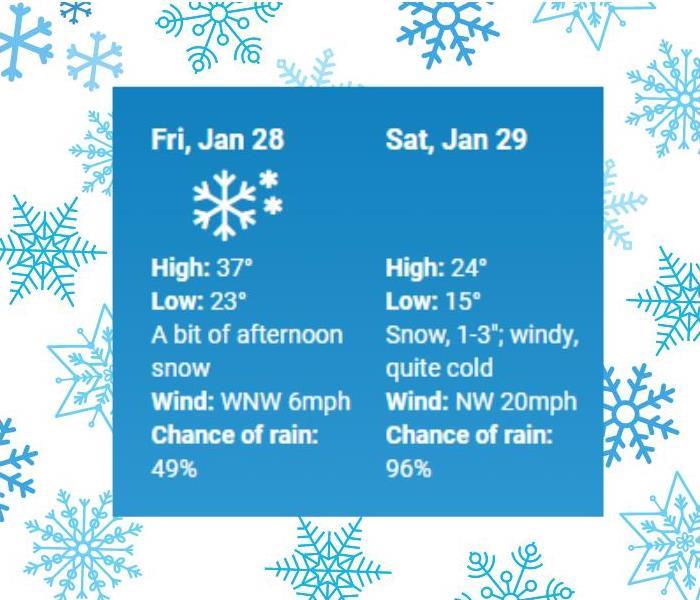 Be aware of the wind chill. Dress appropriately and avoid staying in the cold too long. Stay safe!
Be aware of the wind chill. Dress appropriately and avoid staying in the cold too long. Stay safe!
Winter Storm Watch
Start Friday, January 28, 7:00 PM EST
End Saturday, January 29, 7:00 PM EST
WINTER STORM WATCH IN EFFECT FROM FRIDAY EVENING THROUGH SATURDAY EVENING...
Heavy snow possible. Total snow accumulations of 6 to 12 inches possible. Winds could gust as high as 45 mph.
The coastal counties of New Jersey including Toms River, Bayville, Seaside Heights and surrounding towns according to AccuWeather.
IMPACTS Travel could be very difficult to impossible.
ADDITIONAL DETAILS Snow is expected to begin Friday evening in Delmarva and southern New Jersey, spreading northward overnight into Saturday morning. Snow may be heavy at times through mid afternoon before diminishing Saturday evening. Strong winds may generate blowing snow and very low visibilities at times. The storm total snow forecast remains very uncertain, so stay tuned to the latest forecasts.
PRECAUTIONARY/PREPAREDNESS ACTIONS
Flooding Information for Your Home or Business
9/17/2021 (Permalink)
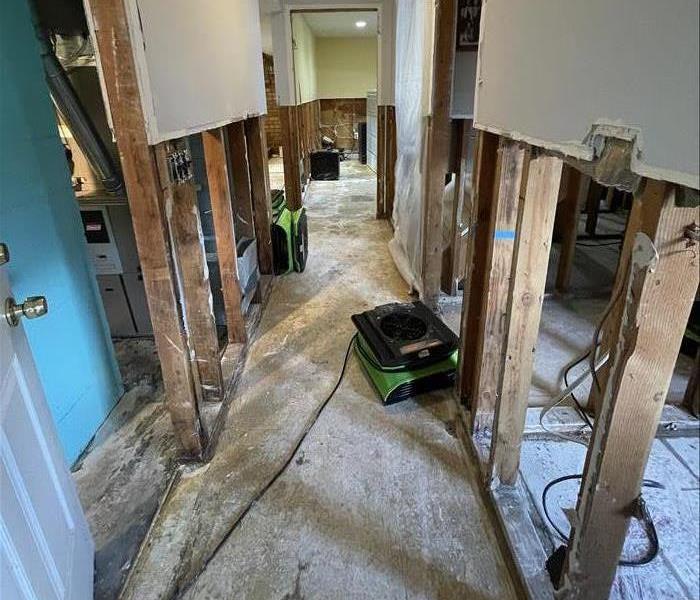 SERVPRO of Toms River understands that every flood damage is different and requires a unique solution. Call us today at 732-349-9898.
SERVPRO of Toms River understands that every flood damage is different and requires a unique solution. Call us today at 732-349-9898.
What is flooding?
Flooding is a temporary overflow of water onto land that is normally dry.
What could cause flooding?
- Result from rain, snow, coastal storms, storm surges and overflows of dams and other water systems.
- Develop slowly or quickly. Flash floods can come with no warning.
- Cause outages, disrupt transportation, damage buildings and create landslides.
What you should know about Flood Safety:
- Make a family emergency communication plan and include pets.
- Have emergency supplies in place at home, at work, and in the car.
- Check on your neighbors to make sure they’re okay.
- Know what to do before, during, and after a flood.
- Flood insurance takes 30 days to take effect.
- Listen to local officials by radio, TV or social media.
- Evacuate when advised by authorities or if you are in a flood or flash flood prone area.
- If you are on high ground above flooded areas, being prepared to stay where you are may be the best protection.
- Never drive or walk through flooded streets.
For FEMA's Be Prepared for a Flood information sheets, click here.
When can you return to your home after a flood?
Pay attention to authorities for information and instructions than return home only when authorities say it is safe.
What can you do to restore your home or business after a flood?
Call SERVPRO of Toms River as soon as possible. has the specialized training and expertise to restore your home back to its pre-storm condition. Our restoration process puts an emphasis on scientific drying techniques, progress monitoring and documentation. Our quick response will help prevent secondary damage and help reduce restoration costs.
Tropical Depression Henri dumps more than 8 inches of rain on parts of NJ
8/30/2021 (Permalink)
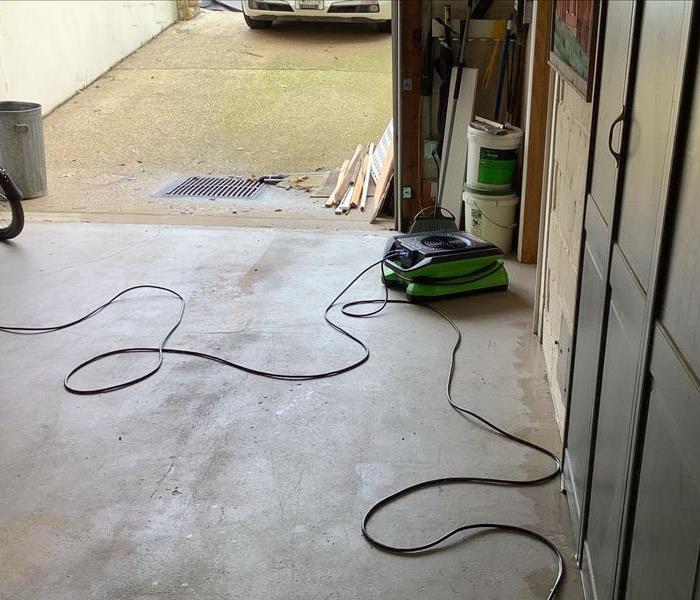 When a storm hits your home or business, you need help immediately. Our quick response will help return to normal quickly.
When a storm hits your home or business, you need help immediately. Our quick response will help return to normal quickly.
Though Hurricane Henri was expected to avoid a direct hit on New Jersey, the National Weather Service was forecasting it would bring heavy rain, strong winds, and flash flooding, with the northern half of the state at the most risk for the torrential weather. Henri was upgraded from a tropical storm to a hurricane late Saturday morning. Rain and wind in New Jersey were expected to begin sometime Saturday night. Luckily, the storm was downgraded to a tropical depression before and Ocean County did not get a direct hit. We did experience heavy rainfall, with Toms River receiving about 2.87 inches, Manchester 2.1 inches and Jackson 2.27 inches. Some other areas in New Jersey received more than 8 inches, according to NJ.com.
Do you know the difference between a tropical storm and tropical depression?
A tropical depression is a tropical cyclone that has maximum sustained surface winds (one-minute average) of 38 mph (33 knots) or less. A tropical storm is a tropical cyclone that has maximum sustained surface winds ranging from 39-73 mph (34 to 63 knots), according to the National Weather Service.
New Jersey was under a tropical storm watch because the path for Tropical Storm Henri was uncertain until it got closer to New Jersey. As the path became certain, Ocean County was going to avoid a direct hit and the storm’s intensity decreased. We were just going to get the outer bands from the storm which means rain, rain and more rain with a chance of flooding.
Do you know the difference between a tropical storm watch and a tropical storm warning?
A tropical storm watch is issued when Tropical Storm conditions, including winds of 39-73 mph, pose a POSSIBLE threat to a specified coastal area within 48 hours. A tropical storm warning is issued when Tropical Storm conditions, including winds of 39-73 mph, are EXPECTED in a specified coastal area within 36 hours or less.
If your property experienced storm damage for the storm, call SERVPRO of Toms River to quickly and properly restore your structure. We have specialized training and expertise to restore your home back to its pre-storm condition. Our restoration process puts an emphasis on scientific drying techniques, progress monitoring and documentation.
Could NJ be looking at more rainfall and more flooding this week due to Hurricane Ida heading to NJ?
8/30/2021 (Permalink)
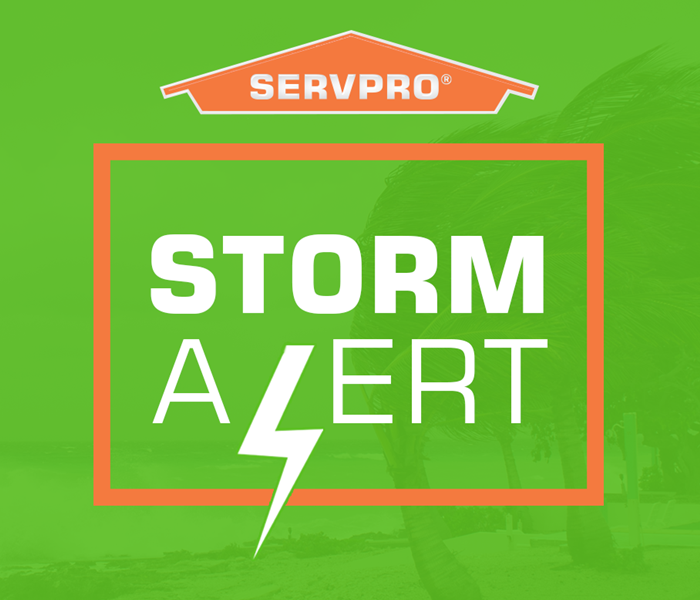 A fast response to flooding is a critical part of limiting the damage and getting your family back to normal.
A fast response to flooding is a critical part of limiting the damage and getting your family back to normal.
As Hurricane Ida makes a right turn and heads towards NJ, it is expected to be downgraded from a category 4 hurricane but it could still bring lots of rain and flooding to Ocean County when it arrives. After an already wet summer from lots of storms including Tropical Storm Fred and then Tropical Storm Henri, Ida is predicted over the next few days to weaken into a tropical depression when it arrives in NJ. The center (or eye) of the storm appears to be heading right towards NJ. Forecasters are predicting the 200 mile wide storm to arrive in NJ sometime on Wednesday or Thursday depending on her speed and if her paths shifts a bit. Ida may bring up to 4-6 inches of rainfall to the Garden State this week.
Hurricane Ida is probably going to bring more rain and cause more flooding problems. Significant flash flooding may become a concern starting Wednesday due to the heavy rain and flooding that was brought to us last week when Tropical Storm Henri came through. A Flash Flood Watch has already been issued for most of New Jersey, from Wednesday morning through Thursday evening. The weather service said flooding is possible in creeks, streams and areas with poor drainage. Water is expected to cover roads, particularly in low lying areas.
SERVPRO of Toms River has the Resources to Handle Major Storms and Disasters
We are locally owned and operated, so we can respond immediately with our highly trained technicians. You can trust our professionals to handle your damages with care, precision, and expert knowledge.
Have Storm or Flood Damage? Call us SERVPRO of Toms River today at 732-349-9898.
Want to Be Severe Storm Ready?
7/28/2021 (Permalink)
 This is the time of year that Toms River and Ocean County get many severe weather and storms. Always be prepared with an emergency kit.
This is the time of year that Toms River and Ocean County get many severe weather and storms. Always be prepared with an emergency kit.
Some dangers of severe weather and storms include tornadoes, strong winds, hail and flash flooding. There is not always time to get everything we may need together quickly before the storm, so always have stuff ready for quick evacuation. Some items you may want to have packed and ready include:
- non-perishable food
- manual can opener
- water
- battery powered radio
- flashlight
- lanterns
- extra batteries
- personal hygiene items
- medications
- first aid supplies/kit
- copies of important documents
- cell phone fully charged
- important contact information for family and friends
- blankets
- change of clothes
- pocket knife
- rain gear
- cash
What should my first aid/medical kit contain?
- sterile adhesive bandages
- antiseptic
- tape
- compresses
- pain relievers
- scissors
- tweezers
- first aid guide
- moist towelettes
What important documents should I copy and have ready?
- insurance cards
- medical records
- bank numbers
- credit card numbers
- copies of birth certificates and/or marriage licenses
- copy of social security cards
- other personal documents
- copy of wills
- titles of cars and properties
- house inventory photos
Never leave your pets behind and make sure you have enough extra food, water, leashes, medicines and vet records for them.
We all hope to never need to use these emergency kits but it is always better to be prepared just in case an emergency strikes.
What Damage Can Floodwater Cause In My Island Heights Home?Home
6/15/2021 (Permalink)
What destruction does floodwater cause?
When floodwater gets into your Island Heights property, it can infect everything it touches because it usually contains harmful microorganism. Murky water can conceal insects and even life-threatening wildlife. The pooling floodwater can cause long-term damage to items such as:
- Drywall and wallboard - These materials are porous, and when they absorb water, they may become weak and remain contaminated even after drying.
- Floor coverings - Laminated covers with foam rubber backing, can be destroyed beyond repair. Carpets that come into contact with contaminated water need to be replaced.
- Electrical wiring and pipes - Flooding can cause pipes to break. It can also ruin electrical wiring, leading to electrocution hazards.
- Laminated wood and particle board: These materials can swell, separate, and weaken after getting wet, typically not salvageable.
Which restoration services does SERVPRO professionals offer?
Since floodwater poses health risks to humans, it is essential to let SERVPRO professionals conduct the restoration process. Before we start removing the contaminated water, we wear protective gear such as face masks, full bodysuits, rubber boots, and chemical resistant gloves. Our flood damage restoration services include:
- Floodwater extraction - We can use self-priming trash pumps to extract the floodwater. We classify the pumps as slurry, full trash, or semi trash. The classifications are mainly based on the size of solids they can pass. Semi-trash pumps can pass solids less than 5/8” while trash pumps pass solids up to 1¼″. Full trash pumps can pass solids over 3”, and slurry pumps can carry fluid containing mud or sand.
- Drying – Our team performs thorough drying using centrifugal air movers and dehumidifiers. The equipment can remove moisture even in confined spaces. We can dry the contents of your home off-site or on-site.
- Removing and disposing of non-salvageable items.
- Eliminating odors in the property by using different deodorizing products and equipment
Do not let flood damage distort your daily activities. Contact SERVPRO of Toms River at (732) 349-9898 for effective restoration. We’re Faster To Any Size Disaster.
What Can Bring Salt Water Damages to Your Toms River Homes and Businesses?
4/28/2021 (Permalink)
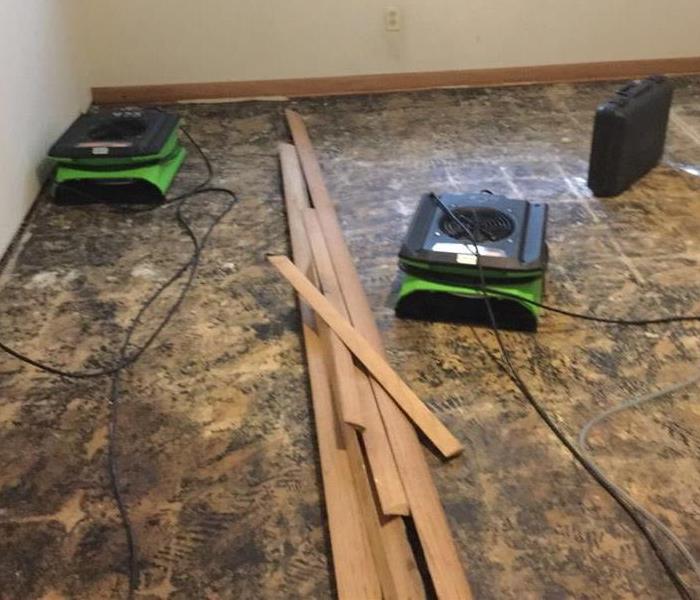 Drying equipment in full effect in this room after all the saltwater was removed.
Drying equipment in full effect in this room after all the saltwater was removed.
Living and working at the Jersey Shore, most of us are pretty familiar with different forms of natural disasters and events that can cause water damage. Most common here in Ocean County, NJ are:
Some of these storms and weather systems move across the landscape, picking up water from the ocean, bays and lagoons and depositing them on properties as it travels.
Storm surges are defined as the abnormal rise in seawater level during a storm, measured as the height of the water above the normal predicted astronomical tide. The surge is caused primarily by a storm’s winds pushing water onshore. The amplitude of the storm surge at any given location depends on the orientation of the coast line with the storm track; the intensity, size, and speed of the storm; and the local bathymetry bathymetry by the National Ocean Service.
Winter storms, such as blizzards, heavy snow and ice storms, do not seem like they belongs on the list but when we receive a lot of snow and it warms up quickly, that melted snow needs to go somewhere. That somewhere from your roof could be through your roof into your home or business and the snow from the ground and landscape could melt into your crawlspace or basement.
Why do these natural events cause so much damage?
The simple answer is water. The more complicated answer is salt in the water. Any water containing salt (saltwater) can be extremely corrosive on metals, such as pipes, and concrete, including foundations, pilings, sidewalks, and structural walls. Plaster, bricks and mortar can also be targets of salt water corrosion. When salt penetrates concrete it holds on and it breaks down very slowly so the process of salt corrosion may takes years to see the full effects.
From salt water damage you cannot just pump out the salt water and expect your property to be back to it’s pre-water damage condition. The system will need to be flushed with fresh water to remove the salt, and then pumped repeatedly until there is no sign of salt remaining.
When a saltwater intrusion occurs in the Toms River area, contact SERVPRO of Toms River. We are certified water loss specialists and our crew work quickly and efficiently to restore your commercial or residential property to its preloss condition.
How Can SERVPRO Dry Cabinets and Cavities in Your Pine Beach Home after Flood Damage?
4/17/2021 (Permalink)
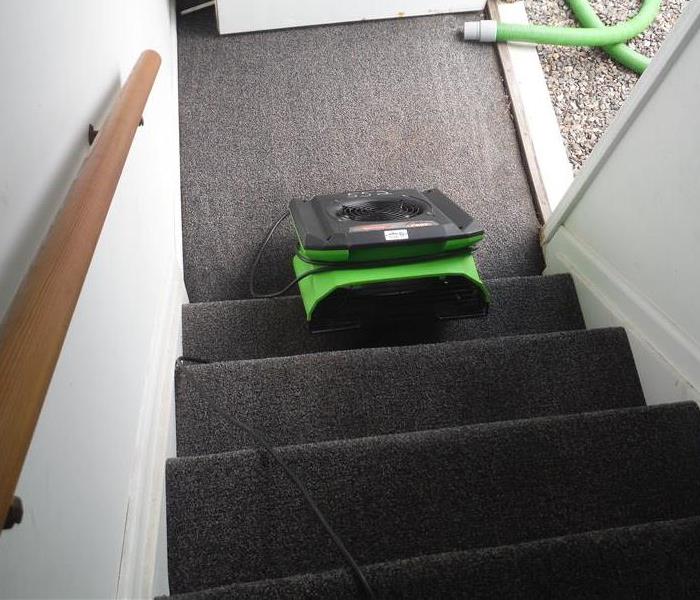 SERVPRO of Toms River's drying equipment at the bottom of a carpeted stairway from water entering this Pine Beach property.
SERVPRO of Toms River's drying equipment at the bottom of a carpeted stairway from water entering this Pine Beach property.
Do wet cabinets dry naturally?
Flooding brings floodwaters into your home and spread throughout your Pine Beach property leading to wet walls behind cabinets and fittings. These areas are particularly challenging to dry because of space limitations and the multiple layers of cabinet backs and drywall. The low ventilation level typically means fittings dry slowly without intervening with equipment and could become hotbeds for microbial growth activity. Drying times are typically longer when cabinet design includes a back. Often drying the wall and the cabinet requires drilling small holes to allow for adequate ventilation and air-flow.
What makes wet cabinets and walls slow to dry?
- The type of paint, either flat paint or glossy, can slow down drying. Flat paint is generally the quickest.
- Cabinet design, mainly whether cabinets include backing.
- Laminated cabinets can be tricky to measure due to the vapor barrier.
Is cabinet disassembly necessary for drying efficiency?
Fittings with water exposure and flood damage in your Pine Beach home are often time-consuming to disassemble. SERVPRO technicians generally opt for drilling vent points into the cabinet walls and using a venting fan to drive air into the cavity. One area that may be useful to drill into is the cabinet toe kick located at the cabinet's bottom. To remove the toe kick, remove the base molding to circulate air into the cavity. With proper care and attention, base molds are reusable so long as they do not sustain permanent harm during removal.
What methods are useful for walls with high exposure to moisture?
- Drill additional holes at the top of the wall to allow full ventilation.
- Insulation in exterior walls can often be savable by drilling additional holes.
- Take extra care to avoid loosening sheetrock, which may be weak due to water exposure.
Cabinet drying typically takes longer but is essential to recovering your home from flood losses. Call SERVPRO of Toms River at (732) 349-9898.
Bizarre Weather and Storms Hit Ocean County in 2020
11/25/2020 (Permalink)
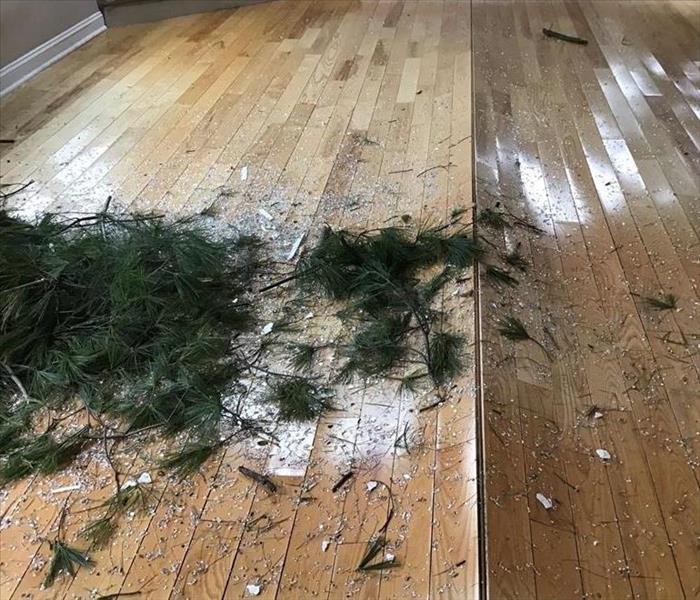 This living room in Toms River shows how much damage a tree on the roof can do to the interior of your home after the microburst.
This living room in Toms River shows how much damage a tree on the roof can do to the interior of your home after the microburst.
2020 Was the Year of Bizarre Weather and Storms in Ocean County
Storm damage does not happen only from hurricanes or tornadoes as Ocean County has learned in 2020. We have not only experienced Tropical Storm Isaias this year, but also a microburst, a waterspout and even something called a derecho.
Tropical Strom Isaias tore through New Jersey in August of 2020 with tornadoes spotted in Barnegat and Stafford. A wind gust of 70 mph was recorded at the Robert J. Miller Airpark according to the Toms River Patch. This storm also uprooted multiple trees in Toms River and destroyed a dugout in Berkeley Township.
A microburst tore through a neighborhood in Toms River near Bay Avenue in April. Block after block, there were downed trees and destroyed houses. The wind was so strong a trailer went airborne and landed on a neighboring property. The National Weather Service classifies a microburst as a localized column of sinking air (downdraft) within a thunderstorm and is usually less than or equal to 2.5 miles in diameter. Wind speeds in microbursts can reach up to 100 mph, or even higher, which is equivalent to an EF-1 tornado!
After that, in June, the derecho came through New Jersey. According to Merriam-Webster, a derecho is a large fast-moving complex of thunderstorms with powerful straight-line winds that cause widespread destruction. HailTrace posted that this wild wind event went from Pennsylvania with winds gusting up to 80 mph from the Harrisburg, PA area all the way to the Jersey shore! One spot in New Jersey even saw winds up to 89 mph!
After these storms hit, there was a wide array of damaged left behind. At SERVPRO of Toms River, we are fully equipped to handle all these different types of storm damage cleanup and repair services including hurricanes, thunderstorms, snowstorms, hailstorms, tornadoes, tropical storms, microbursts and derechos. We strive to make any storm disaster cleanup as painless as possible by working with your insurance company to get you back into your property quickly. Call us 24/7 at 732-349-9898
Carpet Replacement Due to Flooding in Berkeley Township
9/14/2020 (Permalink)
 For 24/7 assistance after a flood, contact SERVPRO of Toms River at (732) 349-9898.
For 24/7 assistance after a flood, contact SERVPRO of Toms River at (732) 349-9898.
What if I Need to Replace My Carpet After a Flood? SERVPRO Removes Unsalvageable Carpet and Replaces It in Your Berkeley Township Home
In Berkeley Township, when our trained technicians need to replace the carpet, they remove the existing contaminated carpet and dispose of it according to local regulations. Unfortunately, floodwater is considered blackwater (level 3) that may carry dangerous contamination, such as harmful bacteria and other microbes. Typically, this contamination means that the carpet needs replacement to ensure the property's residents' health and safety.
How Soon Can I Replace My Carpet After a Flood?
SERVPRO Regulates Humidity Levels Before Installing Carpet
Dealing with flood damage in your Berkeley Township home means that you need a great deal of patience while performing the cleanup and restoration process. Each flooding situation is unique, requiring an individualized plan of action. Before replacing the carpet, technicians remove excess moisture from the surface level through extraction and from the air with dehumidification equipment. Your home should be adequately dried before adding new carpet; otherwise, you may risk damaging the new carpet right away. One component of carpet replacement is seaming the carpet pieces together.
How Do Technicians Seam Carpet?
• They row-cut the carpet to ensure the carpet fits in the room, and the seams are correctly placed.
• Technicians use plywood to secure the carpet and the pad so that the seam does not move during installation.
• They use a seaming iron to heat the seam to melt the glue that adheres to the seams.
• After rolling the carpet into place while the glue is still warm, technicians remove the plywood strip.
• Before stretching the carpet entirely into place, they allow the seam adhesive cooling time.
For 24/7 assistance after a flood, contact SERVPRO of Toms River at (732) 349-9898. We make it, “Like it never even happened.”
How Can I Get Flood Water Out of My Sofa?
8/18/2020 (Permalink)
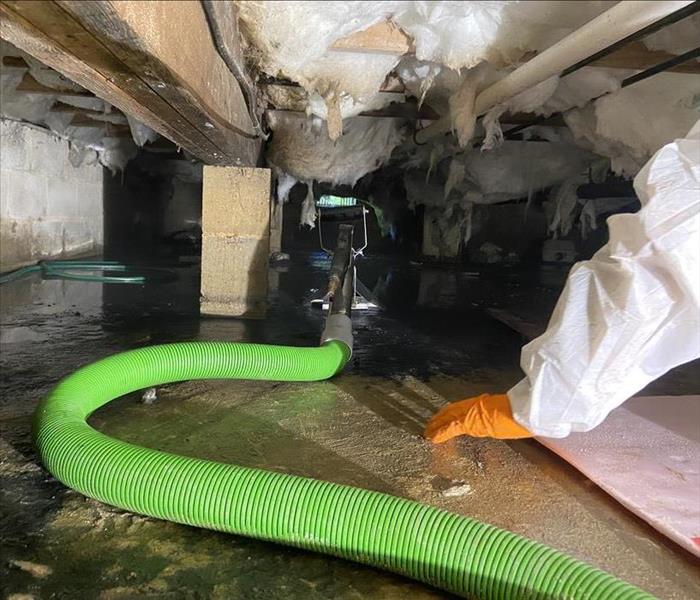 From restoring sofas to drying out and building back crawlspaces, SERVPRO of Toms River can make you feel, "Like it never even happened."
From restoring sofas to drying out and building back crawlspaces, SERVPRO of Toms River can make you feel, "Like it never even happened."
SERVPRO techs have advanced equipment and drying methods to get rid of water damage in your Toms River home
A broken window or a leaky roof in your Toms River home can create some big water damage problems. Ceilings can sag, walls can buckle, and anything upholstered will absorb as much of the water as it can in the fabric and padding. This moisture can also cause the frame to swell or crack. As long as the water is not groundwater and the cleanup began within 24 hours, your favorite sofa may have restoration potential if you hand off the cleaning and drying task to a professional company.
Is It Possible to Get Flood Water Extraction For Carpet Wet From a Storm-Damaged Roof?
Watching water drip down steadily onto your furnishings and carpet in your home and knowing your Toms River property needs flood water extraction, can feel frustrating. Bringing in SERVPRO can speed up the recovery process with the fast action from the techs. Upon arrival, the techs will:
- Perform any needed temporary repairs to halt further water entering
- Determine all areas of water migration in the home
- Remove items that have no damage from the job-site
Structural elements such as ceilings and walls begin to deteriorate once they take on water and need removal. The building services division is a valuable resource. Once the techs complete the mitigation of the floodwater in the home, with their general contractor license #13VH04999700, they can repair or replace any needed elements in the house to restore the property thoroughly. This includes anything from building materials, carpet, painting, or other necessary tasks. Best of all, SERVPRO confirms with your insurance carrier that any action taken is under the scope of coverage, so there are never surprise out-of-pocket expenses.
SERVPRO of Toms River at (732) 349-9898 is available 24/7 for flood water extraction in local properties. The techs bring the latest equipment and advanced restoration techniques for the best outcome from this type of water damage in your home.
How Can I Know that All Flood Waters Evacuated from My Beachwood Home?
6/17/2020 (Permalink)
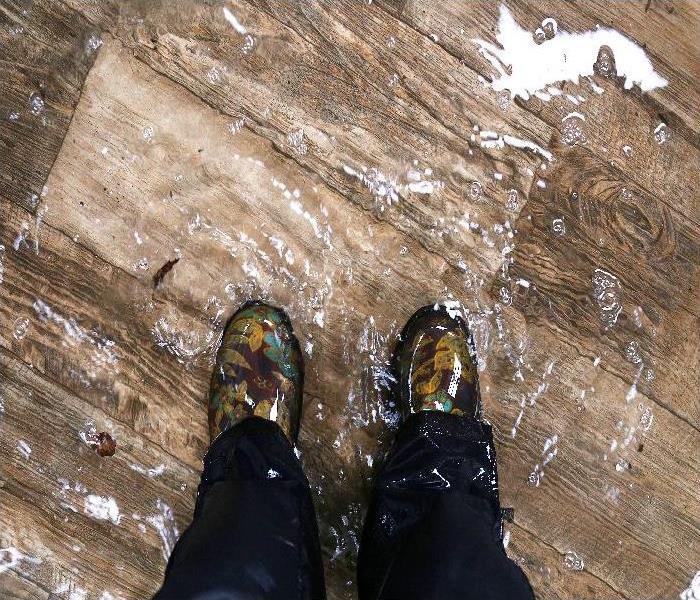 SERVPRO of Toms River offers residents a wrap-around restoration experience after flood damage.
SERVPRO of Toms River offers residents a wrap-around restoration experience after flood damage.
SERVPRO Technicians Use Sensitive Moisture Detection and Measurement Tools to Find and Eliminate Hidden Flood Damage in Beachwood Residences
The floodwaters that sweep through your Beachwood home are only part of the equation when considering how to recover completely from the disaster. The flooding might seem to disappear, but migrated into building cavities:
• Between walls
• Over ceilings
• Under floors
Why Does It Matter? If I Can’t See the Water, How Can It Be a Problem?
Beachwood homes with flood damage hidden from sight are at risk of progressive deterioration of structural components and secondary harm, such as mold damage. Water is incredibly corrosive, and floodwaters are considered contaminated, possibly exposing your family to hazardous chemicals, pathogens from sewage, and a risk of electric shock or fire because metal supports and fasteners hide inside structures but can conduct electricity without warning.
How Do Water Location Strategies Work?
When SERVPRO managers and technicians arrive at the scene, we conduct a safety assessment, including inspection for trapped water, especially if the fluids could contribute to the collapse of walls or ceilings. We look for the following indications on surfaces:
• Staining
• “Sweating”--a gleam on a wall that signals the surface is saturated
• Peeling paint or wallpaper
• Bulging or bubbling
We use moisture detectors and meters, as well as thermal imaging in some cases, to pinpoint where water seems trapped, and the level of saturation to assist in drying goal determinations.
What Is Controlled Demolition? Who Helps Rebuild After Partial Tear Outs?
When we suspect water hides within building cavities, our technicians cut holes in or remove sections of drywall or ceiling tiles to release the water and provide access for drying activity. After the water evacuates and structural drying completes, our rebuilding division can repair or reconstruct the structures demolished for remediation.
SERVPRO of Toms River offers residents a wrap-around restoration experience after flood damage. Call (732) 349-9898 to schedule a prompt assessment and explore all possibilities to make it “Like it never even happened.”
What Should I Do When There is a Stormwater Intrusion in my Toms River House?
4/20/2020 (Permalink)
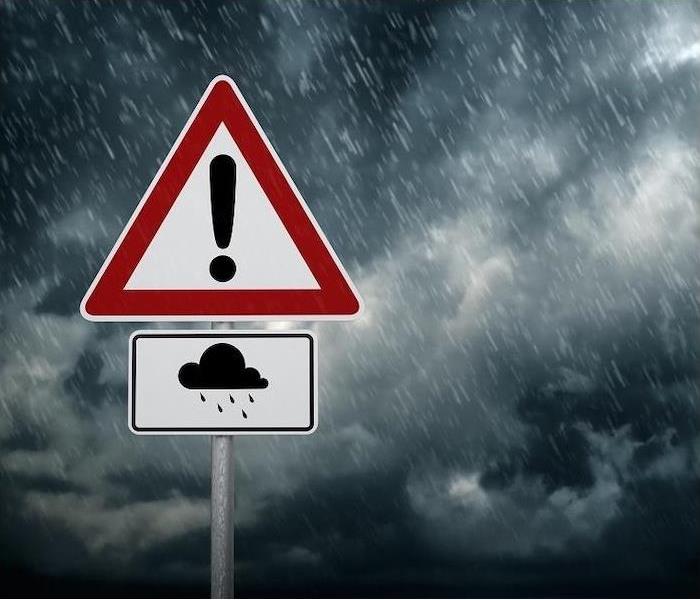 It’s spring flooding time in New Jersey. SERVPRO is equipped to restore your storm damaged home.
It’s spring flooding time in New Jersey. SERVPRO is equipped to restore your storm damaged home.
SERVPRO Helps with Storm Water Extraction in Toms River, and Carries out Other Restoration Steps
Stormwater can find a way into your house in different ways, including breaches on the roof or other openings such as improperly sealed windows. However, rising groundwater causes most incidents involving stormwater in Toms River. The implications of these intrusions can differ depending on factors such as:
- The volume of water involved
- The access points
- The duration the property is submerged or saturated
It is, therefore, crucial to evaluate an incident before taking any steps, whether its cleanup, restoration of the property, or removal of contents.
What factor of stormwater intrusion has the most severe impact?
Each flooding incident is unique. However, the volume of water involved, and the duration the water remains in the house plays a vital role in determining the level of damages. Speeding up stormwater extraction from Toms River properties, therefore, helps minimize the effects the incident might have on your property. Immediate extraction may not always be feasible, so evaluating a situation before taking measures is crucial. Some factors that might delay extraction include:
- The possibility of causing additional damages
- The water outside the structure yet to recede
- Problems finding the right disposal point
Although the removal of storm water from a house helps to prevent damages, it can have the opposite effect. An example of this is pumping out a flooded basement too fast, which can destabilize the foundation walls.
Removing water from the house when the yard and other surrounding areas still flooded may not be feasible since more water would flow back in. Therefore, it is better to wait for the groundwater outside the structure to recede before starting extraction. Our SERVPRO technicians can help you deal with these obstacles in different ways. For example, when pumping out basements, we do it in phases. In case the water is yet to recede, we can take other helpful steps such as moving vulnerable contents from the flooded areas as we wait for the right opportunity to start extraction.
How long is stormwater removal likely to take?
There is no standard timeline for the extraction of water from a flooded house because each case presents different dynamics. However, through the skills gained in training or through experience, our SERVPRO technicians can provide realistic estimates after considering factors such as:
- The size of the property
- The efficiency of the extraction equipment
- The types of contents in the property
- The intrusion points
Apart from a more substantial property having more square feet to hold water, it might also have more rooms, which can delay the removal since each room might require individual attention. Massive contents such as couches or appliances can hamper movement during removal or require relocation, thus delaying the extraction.
Does SERVPRO expedite the removal process?
One of the reasons you should call SERVPRO to handle stormwater extraction from your Toms River property is to capitalize on our preparedness. The incident at your home may be the first or second, but for our technicians, it is part of what they handle during their routine work. Our teams know the quickest ways to accomplish various tasks and anticipate problems that may crop up during restoration, thus take steps to avoid them, eliminating unnecessary delays.
We equip our crews with a variety of extraction equipment to handle any water extraction challenges, including high volumes of water or extraction from hidden sections within the property. Some of the standard equipment in our production trucks includes truck-mounted water extractors and specialized cavity extractors such as injectidry systems.
In certain events, there is a need to open the structure to reach the water from hidden cavities or remove construction materials damaged by flooding. Our technicians make flood cuts, punch vent holes on walls, and drill weep-holes on ceilings to release trapped water faster. Such steps speed up the overall extraction process by improving access to the water or creating room to use extraction equipment better.
What other steps help deal with flooding?
After removing all standing water, there is a need to clean up soiled areas and dry moisture to restore the property to its preloss state. Cleaning is also crucial to remove contaminants, especially when a flooding incident in Toms River involves groundwater intrusion. At the same time, drying helps prevent secondary issues such as mold, bad odor, and other forms of material deterioration such as warping and rotting of wood.
SERVPRO of Toms River is Faster to Any Size Disaster, located to help you extract water from your Berkeley Township, Beachwood, and South Toms River home. Call us at (732) 349-9898 any time you need help.
Avoid Electrical Hazards after a Hurricane or Flood
7/30/2019 (Permalink)
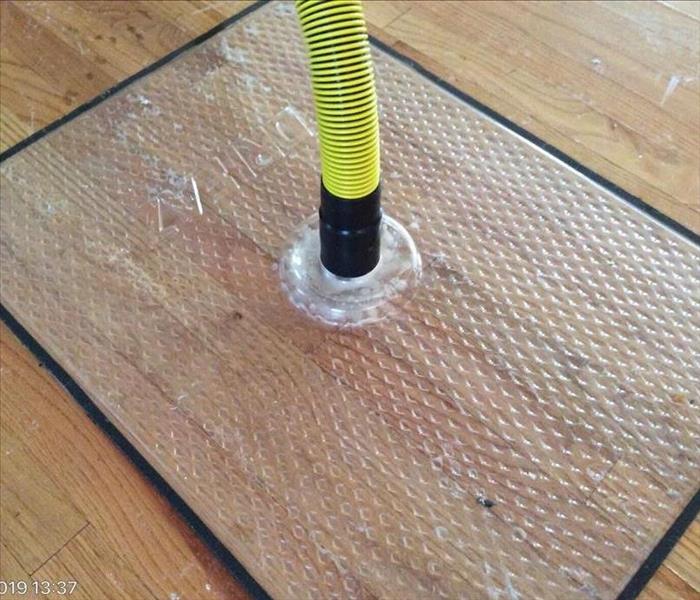 This is just one step in the water extraction process that SERVPRO of Toms River preforms to make it "Like it never even happened."
This is just one step in the water extraction process that SERVPRO of Toms River preforms to make it "Like it never even happened."
After a hurricane, flood or other natural disaster you need to be careful to avoid electrical hazards both in your home and elsewhere. The Center for Disease Control and Prevention recommends these tips to stay safe from electrical hazards:
- Never touch a fallen power line. Always the power company to report fallen power lines.
- Avoid contact with overhead power lines during cleanup and other activities.
- Do not drive through standing water if downed power lines are in the water.
- If a power line falls across your car while you are driving, stay inside the vehicle and continue to drive away from the line. If the engine stalls, do not turn off the ignition. Warn people not to touch the car or the line. Call or ask someone to call the local utility company and emergency services. Do not allow anyone other than emergency personnel to approach your vehicle.
- If electrical circuits and electrical equipment have gotten wet or are in or near water, turn off the power at the main breaker or fuse on the service panel. Do not enter standing water to access the main power switch. Call an electrician to turn it off.
- Never turn power on or off yourself or use an electric tool or appliance while standing in water. Do not turn the power back on until electrical equipment has been inspected by a qualified electrician. All electrical equipment and appliances must be completely dry before returning them to service. Have a certified electrician check these items if there is any question.
- If you see frayed wiring or sparks when you restore power, or if there is an odor of something burning but no visible fire, you should immediately shut off the electrical system at the main circuit breaker.
- Consult your utility company about using electrical equipment, including power generators. Do not connect generators to your home’s electrical circuits without the approved, automatic-interrupt devices. If a generator is on line when electrical service is restored, it can become a major fire hazard and it may endanger line workers helping to restore power in your area.
Take the necessary steps to protect yourself and your loved ones after a hurricane, storm or flood.
If you believe someone has had an electrical shock, do not touch them, call 911 immediately.
After your New Jersey property is safe from all electrical hazards, call SERVPRO of Toms River to begin the water damage cleanup and restoration. For more information on water and storm damage cleanup, call us 24/7 at 732-349-9898.
Flood Damage Prevention Tips
5/15/2019 (Permalink)
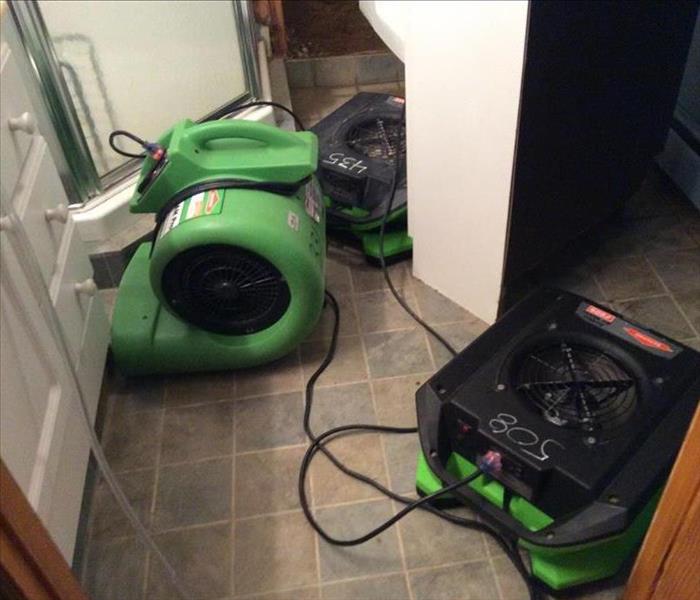 Ocean County suffered heavy rain in August 2018 that resulted in flooding. Brick was one of the areas largely affected with major water damage.
Ocean County suffered heavy rain in August 2018 that resulted in flooding. Brick was one of the areas largely affected with major water damage.
Floods rank as one of the most common and widespread natural disasters in the United States. Whether you live near the Jersey coastline, along city streets or near a river or lake, there is always a potential for suffering flood damage. On average, floods cost $6 billion in annual losses in the U.S. Flooding can also result from plumbing failures, frozen pipes and damaged structures. Flood damage can affect your business operation in a variety of ways and can range in size from being isolated to a single room to entire floors being fully submerged.
Knowing how to prepare and deal with potential flooding in advance can affect how much of your property can be restored and how much has to be replaced. Below are prevention, mitigation and restoration tips to follow until help arrives:
Flood Prevention Tips:
- Determine if your property is in a floodplain.
- In any emergency, always listen to the instructions given by local emergency management officials.
- Carefully assess how your company functions, both internally and externally, to determine which staff, materials, procedures and equipment are absolutely necessary to keep the business operating.
- Plan what you will do if your building, plant or store is not accessible. This type of planning is often referred to as a continuity of operations plan, or COOP, and includes all facets of your business.
- Plan for payroll continuity.
- Review your emergency plans annually. Just as your business changes over time, so do your preparedness needs. When you hire new employees or when there are changes in how your company functions, you should update your plans and inform your people.
- Visit: Ready.gov for a comprehensive plan and to learn about emergency plans for New Jersey.
Flood damage affect not only the structure of your property but also your belongings. SERVPRO of Toms River understands that your home is more than a structure; your family’s furniture, clothing, keepsakes, and other belongings help transform a house into a home. The first 24 hours after flooding are the most important in preventing secondary or permanent damage. Our team is ready to respond as quickly as possible to help our Ocean County community with water cleanup and restoration.
Storm Alberto May Cause Flash Flooding and Downpours Over 5 Days
5/30/2018 (Permalink)
Even though Subtropical Storm Alberto has already crashed ashore on Florida's Gulf Coast,it is expected to churn through the United States on a path far west of New Jersey, but still impact the region, forecasters predict, according to the Toms River Patch. A surge of tropical air may cause downpours to spread over New Jersey and the northeastern United States late this week and into this weekend. New Jersey could see some rain on five straight days from Thursday to next Monday. There is the likelihood of isolated flash flooding incidents in the upcoming weather pattern, according to AccuWeather.
As the pattern evolves, motorists should be prepared for localized, torrential downpours that may quickly flood streets and low-lying portions of highways, according to AccuWeather. From late this week through this weekend, a general 1-3 inches of rain is likely with highly localized amounts up to 6 inches possible.
This storm was the first of the 2018 season to hit the Florida Panhandle this past Monday, dumping up to 8 inches of rain on Alabama and other southern states. It is expected to drench areas as far north as Chicago. After that, it will track through Michigan and into Canada, according to the National Weather Service.
For more information on Storm Alberto please visit TomsRiverPatch/StormAlberto.
Have Storm or Flood Damage?
Call SERVPRO of Toms River Today at (732)-349-9898.
At SERVPRO of Toms River, restoring storm- and flood-damaged properties is the cornerstone of our business. Our highly trained professionals use specialized equipment and advanced training to quickly restore your Ocean County property to pre-storm condition. We’re dedicated to responding immediately, which helps to minimize secondary damage.
Be Prepared for Hurricane Season 2018
5/8/2018 (Permalink)
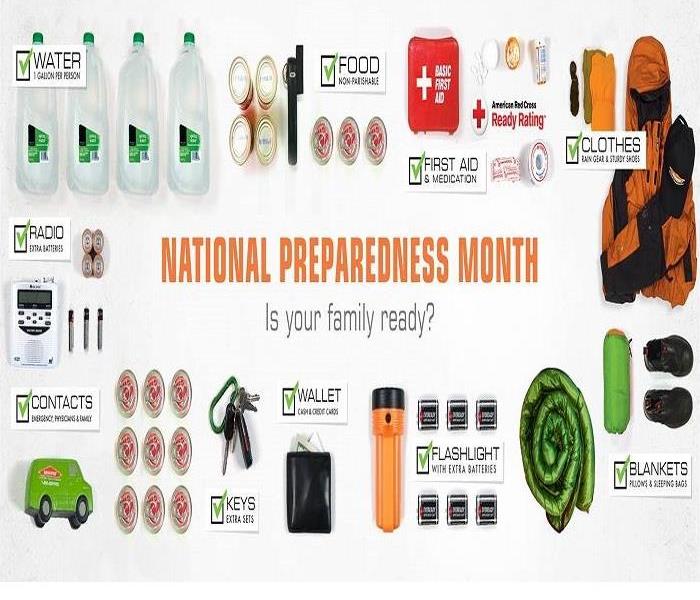 With the start of the Atlantic hurricane season here, now is the time to prepare at the Jersey Shore.
With the start of the Atlantic hurricane season here, now is the time to prepare at the Jersey Shore.
Be Prepared Before a Hurricane Strikes
Living at the Jersey Shore makes us prone to severe weather disasters including hurricanes and tropical storms that may bring coastal flooding. While predicting exactly how much damage a storm will cause is impossible, with some preventive measures, you and your family can try to minimize the potential damage. Here are three things you can do to prepare for flooding from a powerful hurricane or tropical storm:
- Create a Disaster Survival Kit
In case of an emergency you should always have a disaster survival kit that you and your family update every so often. Include items like bottled water, non-perishable food, flashlights, batteries (for radios, flashlights), and a first aid medical kit. Shop early for supplies. Essential items usually sell out fast before a storm. Remember to write down important emergency contact information and insurance documents, as well as essential medications and lastly, do not forget cell phone chargers, either. - Secure Your Home & Valuables
Before the storm arrives, if possible, move or secure any items that are in danger of causing damage or becoming destroyed by strong winds, such as outdoor furniture. Inside the home, you can move furniture, valuables, hazardous materials, and important documents to higher ground inside your home. For safety, remember to shut off the main power supply to your home, as well as unplug all electronics. If you, a loved one or a neighbor have a mobile home, ensure it is properly secured and anchored. - Help Others in Need of Assistance and Protect Pets
In addition to protecting you and your family make sure to help anyone in need of assistance. Before the storm hits, ask them if they need any assistance evacuating or preparing before the storm. Do not forget about pets. If necessary, make special arrangements for safe transport of your pets while remembering to bring any pet medications and enough food to last through the ordeal. If you need a safe place for your pet during the disaster, contact your local animal shelter. Never leave them behind.
We all know flooding is part of living near the water. Here at SERVPRO of Toms River, we are prepared 24 hours a day to cleanup and dry your water damaged property, if you do suffer flooding. We can start the remediation process immediately after you contact us. A faster response lessens the mold damage, limits additional damage, and reduces the remediation cost. We have the experience and advanced training that enables us to restore your property quickly.
Contact us 24/7 at 732-349-9898 for all your storm related damage.
SERVPRO of Toms River is Ready for Whatever Happens. Are you?
4/3/2018 (Permalink)
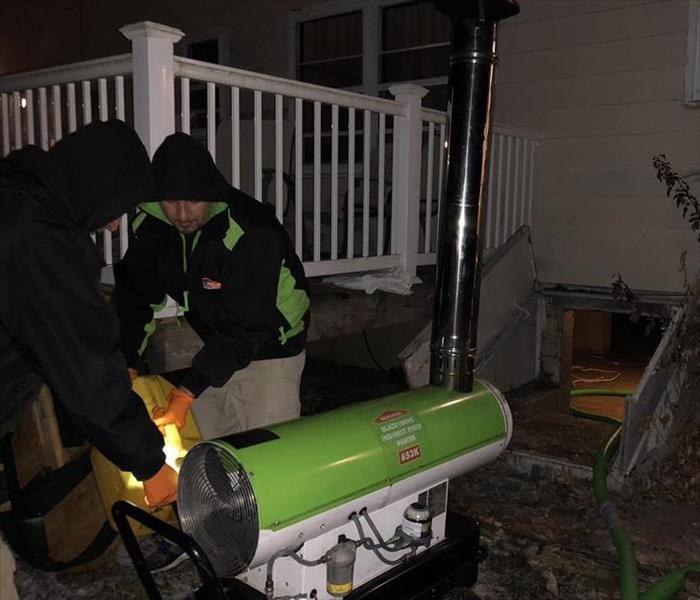 SERVPRO of Toms River is there when you need them, 24 hours a day, 7 days a week, 365 days a year.
SERVPRO of Toms River is there when you need them, 24 hours a day, 7 days a week, 365 days a year.
When a storm or disaster strikes, SERVPRO of Toms River is prepared and ready to take action and you should be too. Be prepared in your home or business with an Emergency Kit. Ready.gov suggests you to have enough supplies to last for at least three days. Below are some suggested items to include in your kit:
- 3 day supply of nonperishable foods
- Water (One+ gallon per person)
- First Aid Kit
- Prescription Medicine
- Sleeping Bag or blankets
- Fire extinguisher
- Hygiene products
- Flashlights
- Extra batteries
- Cell phone charger
- Change of clothes
- Matches in waterproof container
- Wrench or pliers to turn off utilities
- Whistle to signal for help
- Pet supplies
- Infant formula and diapers
- Important documents such as insurance policies, ID’s, and bank records in a plastic container
For a more extensive list, check out Ready.gov.
Whenever or whatever the disaster SERVPRO of Toms River is there when you need them.
Faster to Any Size Flood Disaster
3/21/2018 (Permalink)
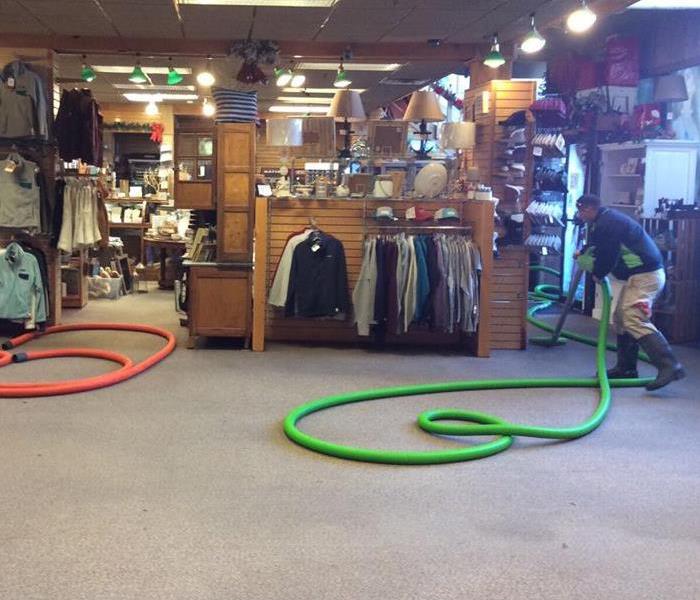 Brave New World experienced flood damage and they called the cleanup team that is faster is any size disaster.
Brave New World experienced flood damage and they called the cleanup team that is faster is any size disaster.
Having a home or business by the Jersey Shore, there is always a potential for flood damage. Floods are one of the most common and widespread natural disasters in the United States. Just because you have not experienced a flood in the past does not mean you will not in the future. Nearly 20% of all flood insurance claims come from moderate to low risk areas.
When flood damage puts the things that matter most on the line, you need the very best help on the line as well. That is why contacting SERVPRO of Toms River as soon as possible is so important. Even minor floods have the potential to cause major damage to a structure when not treated quickly and properly. Call us at 732-349-9898 or visit our storm and flood damage cleanup and restoration page for more information on our services. Our company is a leader in giving control back to home and business owners and even entire communities after the ravaging effects of water.
New Jersey's "Bomb Cyclone"
1/8/2018 (Permalink)
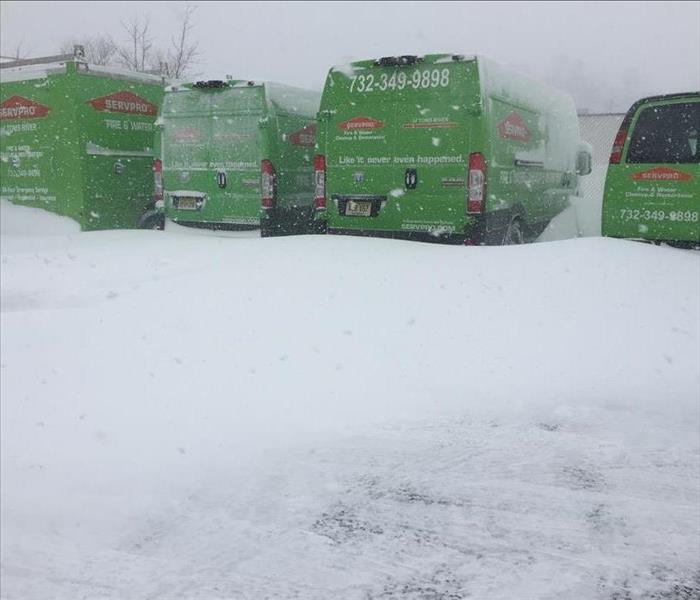 SERVPRO of Toms River's fleet of trucks during the "bomb cyclone" of 2018.
SERVPRO of Toms River's fleet of trucks during the "bomb cyclone" of 2018.
A winter hurricane called a “bomb cyclone” is about to cause problems for New Jersey and all along the East Coast. According to the Toms River Patch, a “bomb cyclone” is a meteorological term and described as such because its pressure is predicted to fall so fast, an indicator of explosive strengthening of the storm.
This “bomb cyclone” will be on the way here after forming off the coast of Florida on Wednesday, Jan 2, 2018. This winter storm is expected to hit New England with strong winds exceeding 45 miles per hour and blizzard conditions on Thursday. Luckily, the worst of the storm will hover 20 to 50 miles, or more, off the Jersey Shore. Worst case scenario is if the storm tracks closer to the coast, then some sections of New Jersey could get hit with as much as 8 to 12 inches of snow.
The temperatures will dip into the polar vortex range, which can cause your pipes to freeze and ice damns that can cause series damage to your home. The term “Polar Vortex” is used when referring to the frigidly cold temperatures we experience during the winter months in many regions of the United States. Thursday night, gusty winds coupled with temperatures that will drop into the single digits and low teens will freeze the Garden State deeper with sub-zero wind chills. Well below freezing temperatures are expected to linger through Friday and Saturday.
In the event of a burst pipe or ice damn damage, call SERVPRO of Toms River at 732-349-9898 for all your storm damage cleanup.
Be Hurricane Ready
9/7/2017 (Permalink)
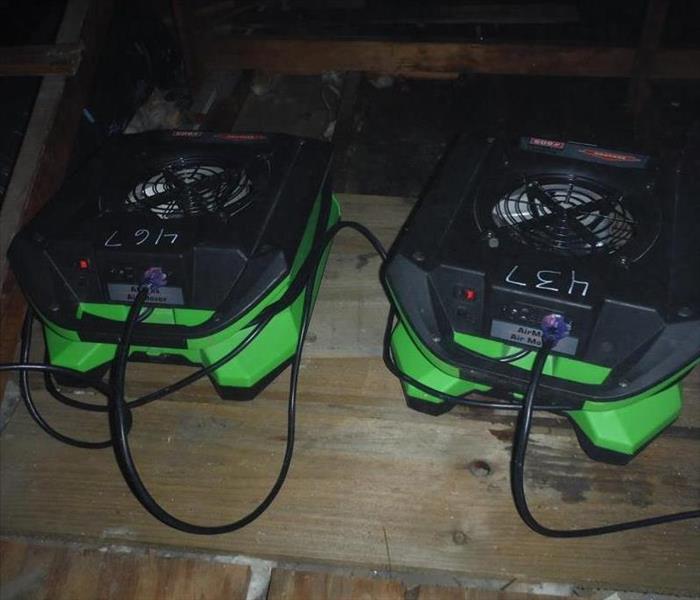 Water damage in this Ortley Beach residence being dried to prevent further damage.
Water damage in this Ortley Beach residence being dried to prevent further damage.
After Hurricane Harvey hit Texas and as Hurricane Irma quickly approaches Florida as a category 5, it reminds the rest of us that we should always plan ahead. Preparation is key to making it through any size disaster. SERVPRO of Toms River offers these simple steps to plan ahead:
- Check your insurance policy to see what is covered and make sure to purchase flood insurance if you do not already have it.
- Review your area’s evacuation plans so in the event of a quick evacuation you will know where to go.
- Make sure your residence is hurricane ready by checking for existing damage and fixing whatever needs to be fixed.
- Purchase supplies and have them organized together in case you need to evacuate or in case you are without power for some time. Please use the American Red Cross Checklist for a list supplies you will need.
- Make copies of all your important documents and store them in a dry, safe place.
- Take pictures of your residence and belongings and keep them in a dry, safe place.
After a hurricane, we are dedicated to responding immediately to your water and storm damage emergency. Our highly trained professionals use specialized equipment and advanced training to quickly restore your Toms River property to pre-storm condition. Major storms and flooding events can overwhelm many restoration companies. On the other hand, SERVPRO of Toms River can access resources from 1,700 Franchises across the state and country and even utilize Disaster Recovery Teams for major storms and disasters.
To help those impacted by Hurricane Harvey, please donate to the American Red Cross.
Hurricane Preparedness Week is May 7-13, 2017.
4/27/2017 (Permalink)
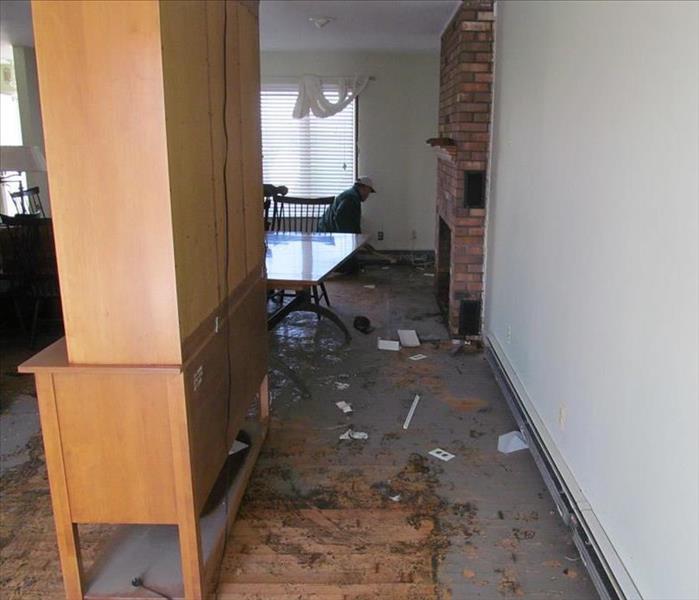 SERVPRO of Toms River cleaning up storm damage from Hurricane Sandy,
SERVPRO of Toms River cleaning up storm damage from Hurricane Sandy,
Hurricane Preparedness Week is May 7-13, 2017.
Hurricane season in New Jersey is June 1st through November 30th and since it can only take one storm to change your life, it pays to be prepared. Planning ahead for a major disaster may help to minimize damage to yourself, loved ones, pets, home and belongings.
The goal of Hurricane Preparedness Week is to inform people about hurricane hazards and provide knowledge that can be used if one occurs. If you haven’t done so in the past, there is no better time than hurricane preparedness week to begin.
Every day during Hurricane Preparedness Week will focus on a specific topic:
- Sunday May 7th Determine Your Risk
- Monday May 8th Develop an Evacuation Plan
- Tuesday May 9th Assemble Disaster Supplies
- Wednesday May 10th Secure an Insurance Checkup
- Thursday May 11th Strengthen Your Home
- Friday May 12th Check on Your Neighbors
- Saturday May 13th Complete Your Written Hurricane Plan
Please visit The National Weather Service for more information on these specific topics .
The American Red Cross offers a Hurricane Safety Checklist and FEMA offers a guide on How to Prepare for a Hurricane.
In the event that you need emergency service or storm damage cleanup after a hurricane, call SERVPRO of Toms River at 732-349-9898.
After a Flood
2/14/2017 (Permalink)
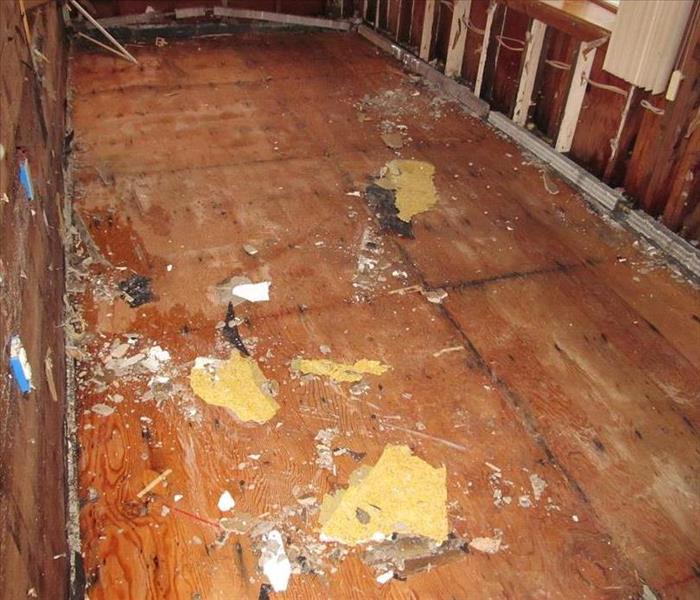 After a flood, SERVPRO of Toms River was called to this Toms River home to begin the process of cleaning, drying and restoring the home.
After a flood, SERVPRO of Toms River was called to this Toms River home to begin the process of cleaning, drying and restoring the home.
After a Flood
After a flood mold can spread quickly through your Ocean County home or business in as little as 48 hours. Water damaged areas and items should be dried within 24-48 hours to prevent mold growth. If you were unable to properly dry your belongings and control the moisture within this time period, you should assume that you have mold growth. Just because you cannot see it does not mean that it is not present. It may be hidden under or behind items like carpet, cushions, or walls. Flood waters may also have carried sewage or chemicals into your home. This could expose you or your family to viruses, bacteria, disease carriers (such as mosquitoes), and parasites, as well as mold.
Cleaning up yourself after a flood can pose certain health risks to you and your family. Before you start the cleanup process ask yourself if it is too dangerous or difficult to do yourself. If you are unsure it may be best to get help from experienced and qualified professionals. As leaders in the water damage and mold remediation industry, SERVPRO of Toms River has advanced training and expertise, not to mention a tremendous amount of hands-on experience. We use this training and experience to quickly dry your home and restore it back to pre-storm condition.
Restoring flood-damaged properties is the cornerstone of our business. Our highly trained professionals use specialized equipment and advanced training to quickly restore your Toms River property to pre-flooding condition. We’re dedicated to responding immediately, which helps to minimize secondary damage.
Have Flood or Mold Damage?
Call Us Today (732) 349-9898
Prepare Your New Jersey Business for Cold Weather and Winter Storms
1/26/2017 (Permalink)
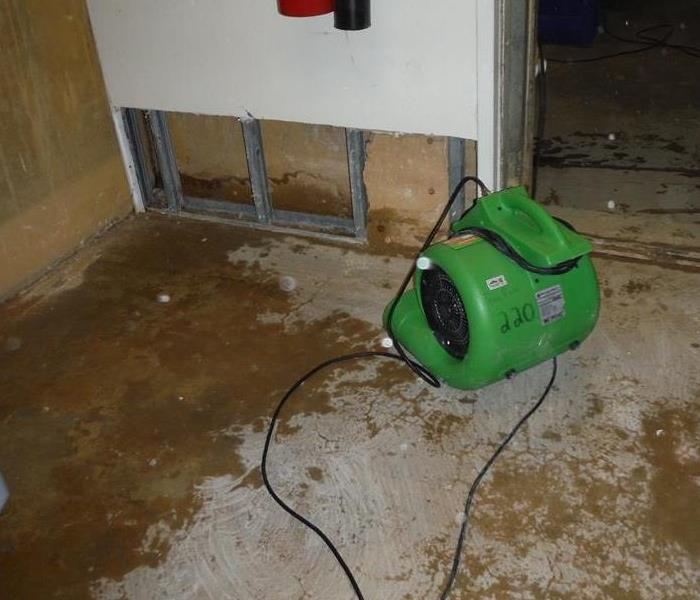 This Lakewood business suffered from a winter storm and our team was there to clean up the water and dirt that the storm brought into the building.
This Lakewood business suffered from a winter storm and our team was there to clean up the water and dirt that the storm brought into the building.
Prepare Your New Jersey Business for Cold Weather and Winter Storms
The effects of cold weather and winter storms (blizzards, snow storms, wind, heavy rains and ice) are a leading cause of business interruption. When a business cannot fully function, profits are affected. Taking preventative actions can help prevent a lot of problems from occurring during cold weather.
Tips to prepare ahead to avoid damage later:
- Check your business property for downed tree limbs and branches, which could cause damage to the property and potentially cause personal injuries.
- Inspect property, especially walkways and parking lots, for proper drainage to alleviate flood hazard potential.
- Inspect all handrails, stairwells and entryways to address and correct potential slippery or hazardous areas. Install mats or non-slip surfaces and post caution signs where water could be present.
- Ask your local SERVPRO of Toms River about starting an Emergency Ready Profile for your business.
If your business suffers winter-related damages, call SERVPRO of Toms River, servicing all of New Jersey. We’re dedicated to responding immediately when you contact us. A fast response lessens the damage, limits further damage, and reduces cost.
Call us at 732-349-9898
Flood Preparation
1/23/2017 (Permalink)
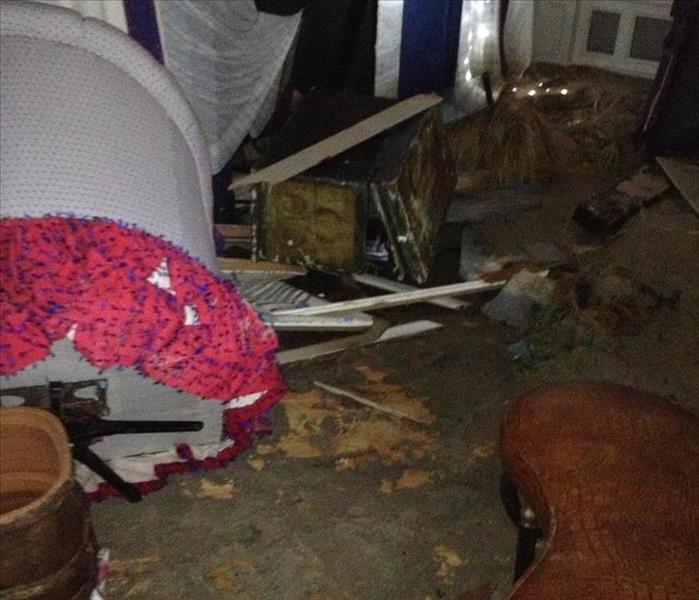 Flooding in Ocean County, NJ can cause all different types of damage.
Flooding in Ocean County, NJ can cause all different types of damage.
Prepare for a Flood with an Emergency Preparedness Kit
According to the American Red Cross, floods cause more damage in the U.S. every year than other weather related disasters.
The American Red Cross says you should have all supplies in an easy to carry emergency preparedness kit which should contain at a minimum the items listed:
- Water: one gallon per person, per day (3-day supply for evacuation, 2-week supply for home)
- Food: non-perishable, easy-to-prepare items (3-day supply for evacuation, 2-week supply for home).
- Flashlight and extra batteries
- Battery powered radio and extra batteries
- First aid kit
- Medications (7-day supply) and medical items
- Emergency Blanket
- Sanitation and personal hygiene items
- Copies of personal documents (medication list and pertinent medical information, proof of address, deed/lease to home, passports, birth certificates, insurance policies)
- Cell phone with chargers (preferably solar charging)
- Family and emergency contact information
- Extra cash
- Map of your area
Also take into consideration what is needed to care for babies, children, the elderly, and pets and make sure to include them into your emergency preparedness kit.
In the event you experience a flood, call SERVPRO of Toms River. We are locally owned and operated so we are always ready to respond to your water damage emergency.
Phone: (732) 349-9898
Storm Damage Cleanup and Restoration in Toms River, NJ
1/18/2017 (Permalink)
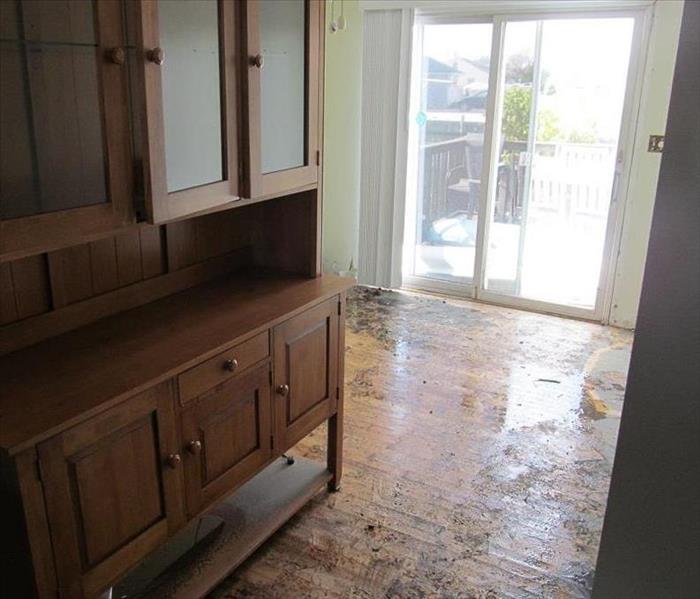 SERVPRO of Toms River was there to help our local residents who were lives and homes were devastated by Hurricane Sandy.
SERVPRO of Toms River was there to help our local residents who were lives and homes were devastated by Hurricane Sandy.
Storm Damage Cleanup and Restoration in Toms River, NJ
Storm and flood damage should be attended to quickly after the storm has passed in order to reduce costs and minimize secondary damage. SERVPRO of Toms River is one of the most trusted storm damage cleanup and restoration companies serving Toms River, NJ and nearby towns. If your home or business is damaged by a hurricane, tornado, blizzard or flood, we can help aid your recovery efforts.
Beautiful but Vulnerable Communities
The coastal lifestyle is enviable, but it’s not without its risks. In 2012, Hurricane Sandy had a devastating impact on New Jersey, particularly in Toms River. NJ.com reported that more than 10,500 Toms River homes sustained some level of damage from the storm, and the town accounted for 900 of the 9,000 households that received state grants to rebuild or elevate their homes.
While Hurricane Sandy was considered a once-in-a-lifetime storm, it reminded us of Mother Nature’s unpredictability. Atlantic hurricane season is an annual threat to NJ, as are powerful winter storms that can cause significant damage of their own.
Storm Damage Repair Experts
Storm damage and restoration is one of our main areas of expertise here at SERVPRO of Toms River. Our storm and flood services include:
- Disaster Response and Recovery
- Water Damage Restoration
- Contents Restoration
- Move-Outs (if needed)
- Mold Remediation
- Sewage Cleanup
- Carpet Cleaning
- Odor Removal
- Building Services
- Commercial Storm Damage Repair
- Commercial Large Loss Recovery
Why SERVPRO of Toms River?
A storm can strike at any time. That’s why SERVPRO of Toms River is available 24/7 to provide:
- Immediate Response
- Highly Trained and Experienced Professionals
- Specialized Equipment
- Assistance with Any Disaster of Any Magnitude
- Emphasis on Restoring Over Replacing
- Personalized, Local Care Backed by a Nationally Trusted Name
SERVPRO of Toms River stands ready to mobilize in the towns of Toms River, Beachwood, Seaside Heights, Lavallette, Pine Beach, Berkeley Township, South Toms River, Seaside Park, Ortley Beach and Ocean Gate. For any of your storm damage cleanup and restoration needs, call us at 732-349-9898, or request help online.
 As a leader in flood damage restoration, SERVPRO of Toms River has the specialized training to restore your home back to its pre-flood condition.
As a leader in flood damage restoration, SERVPRO of Toms River has the specialized training to restore your home back to its pre-flood condition.




 24/7 Emergency Service
24/7 Emergency Service




























